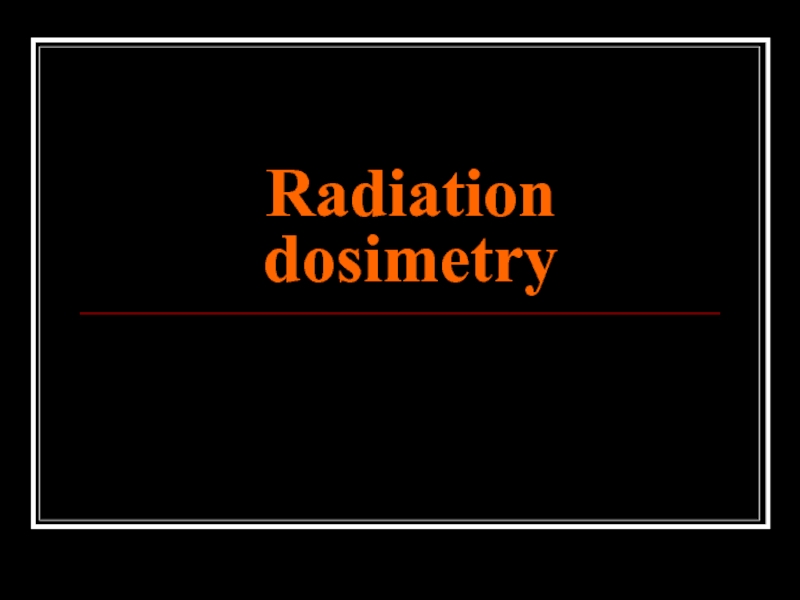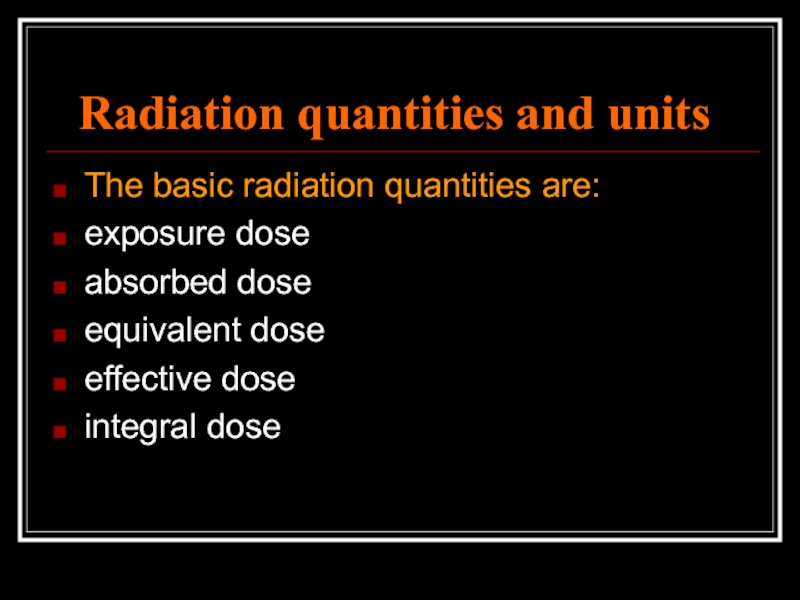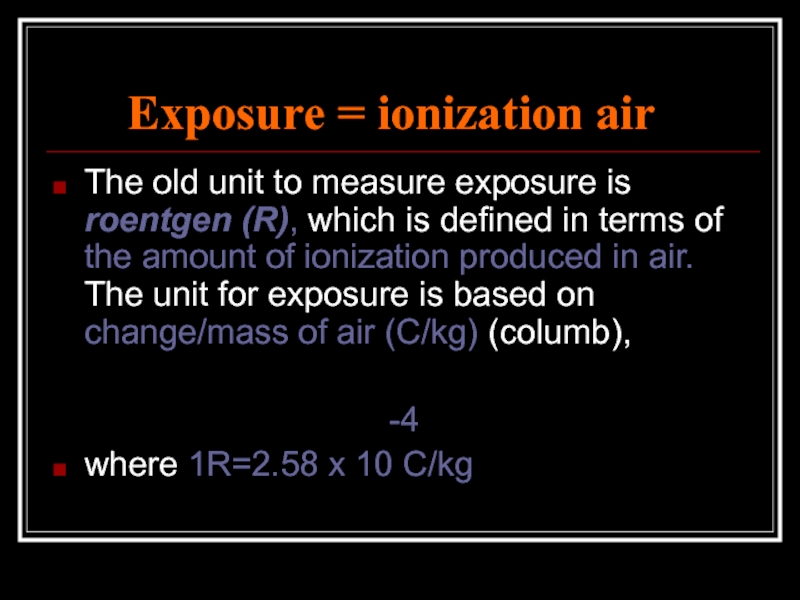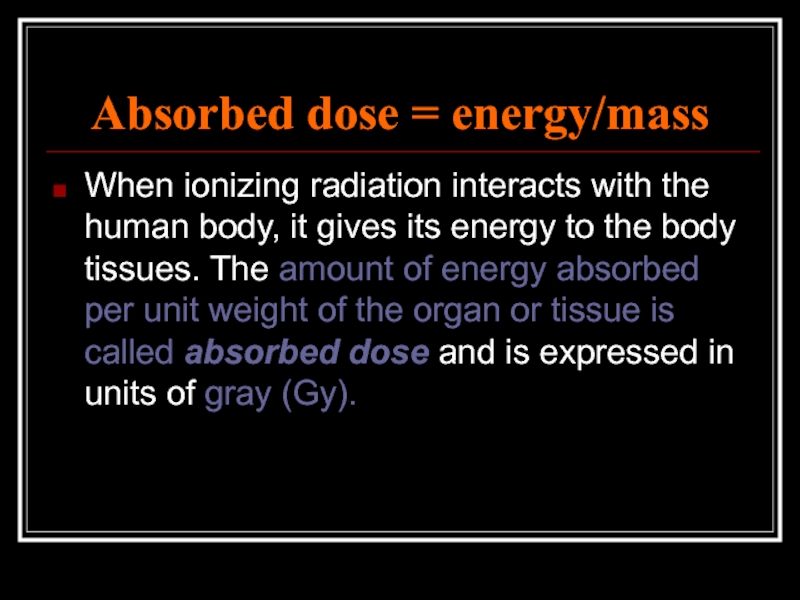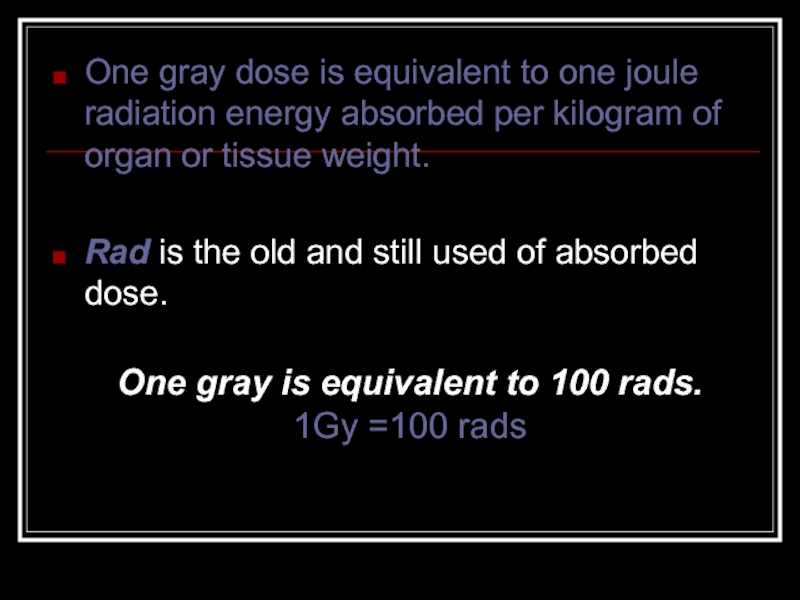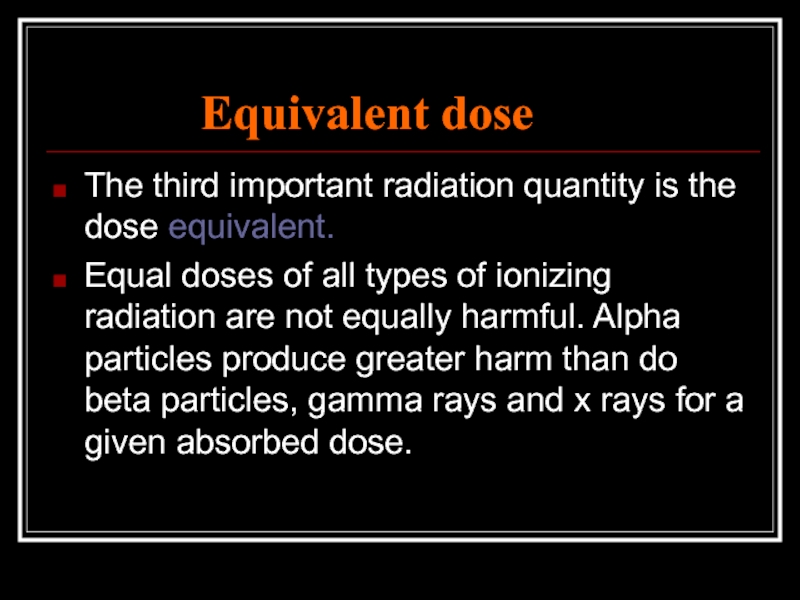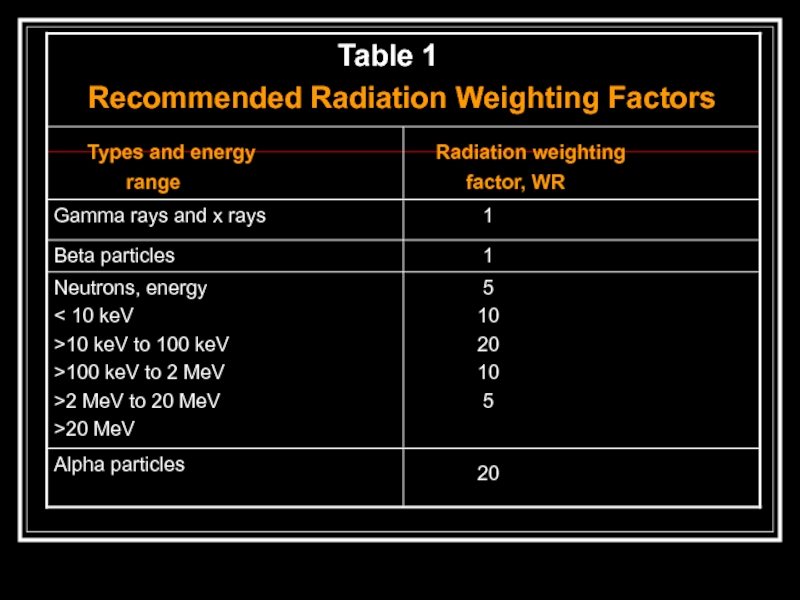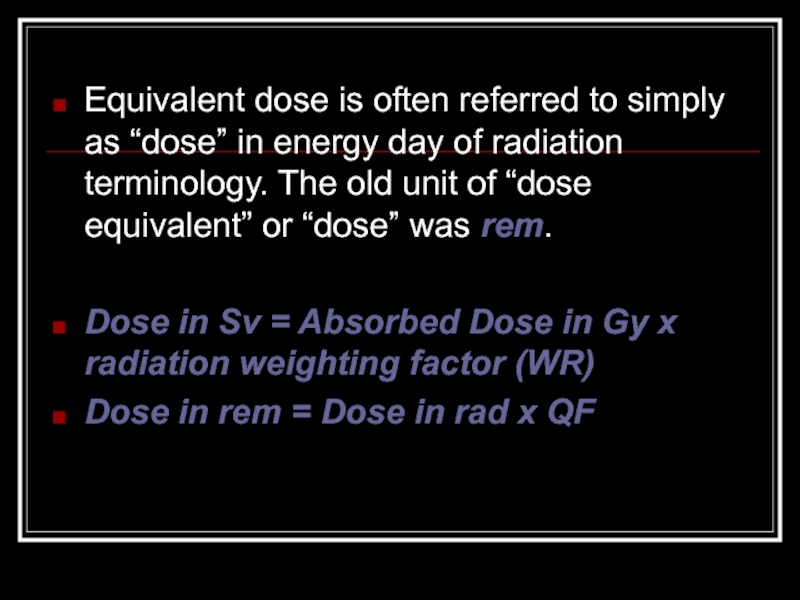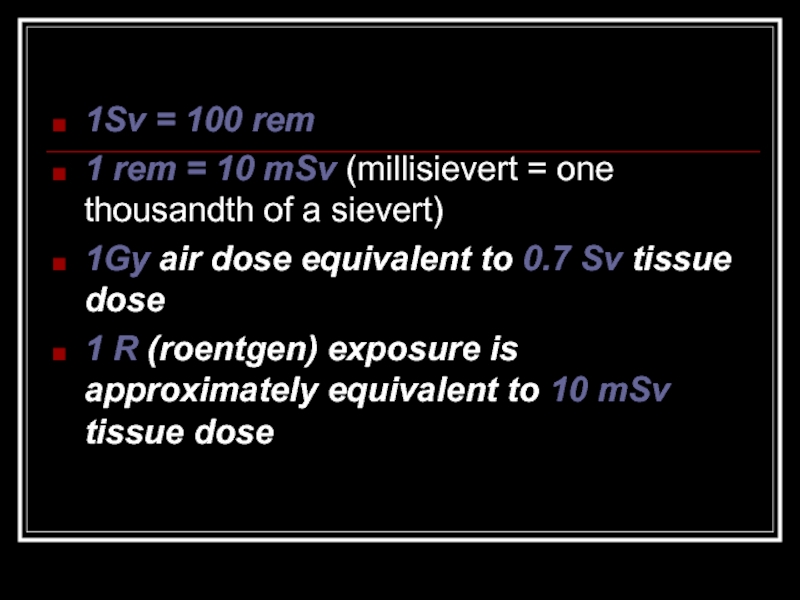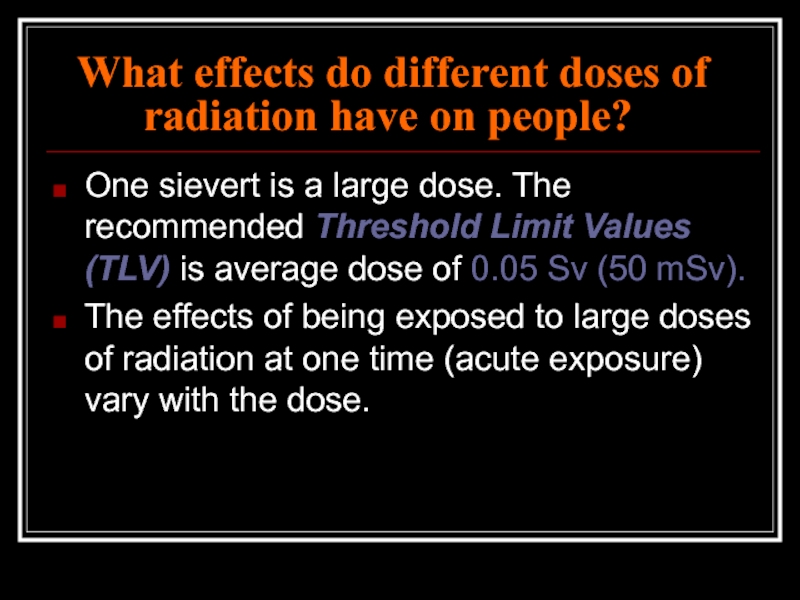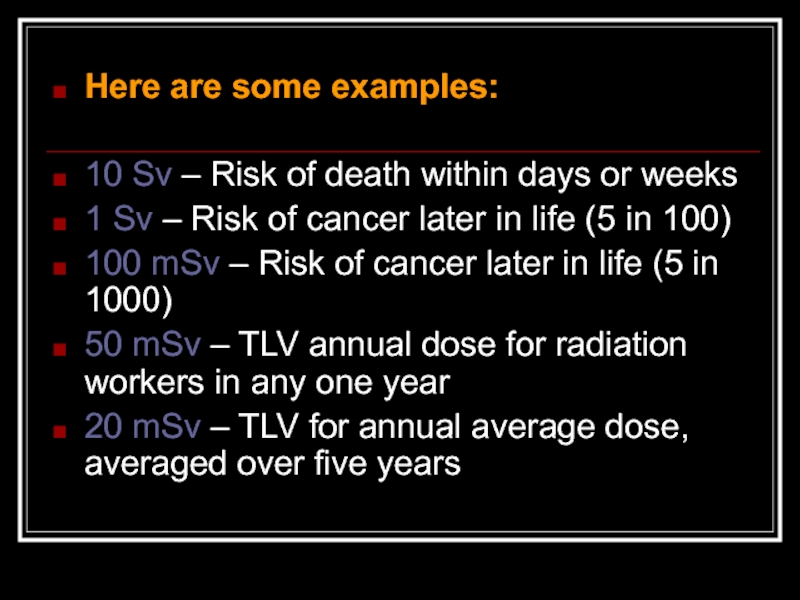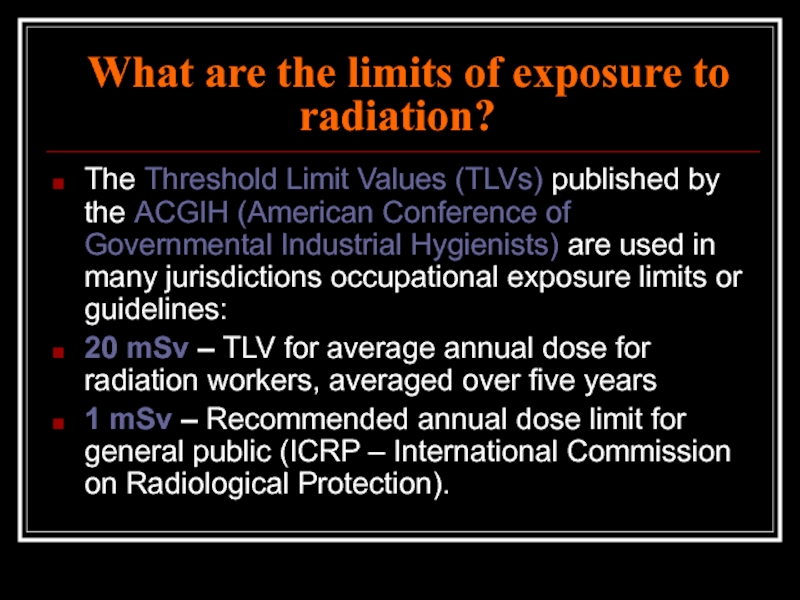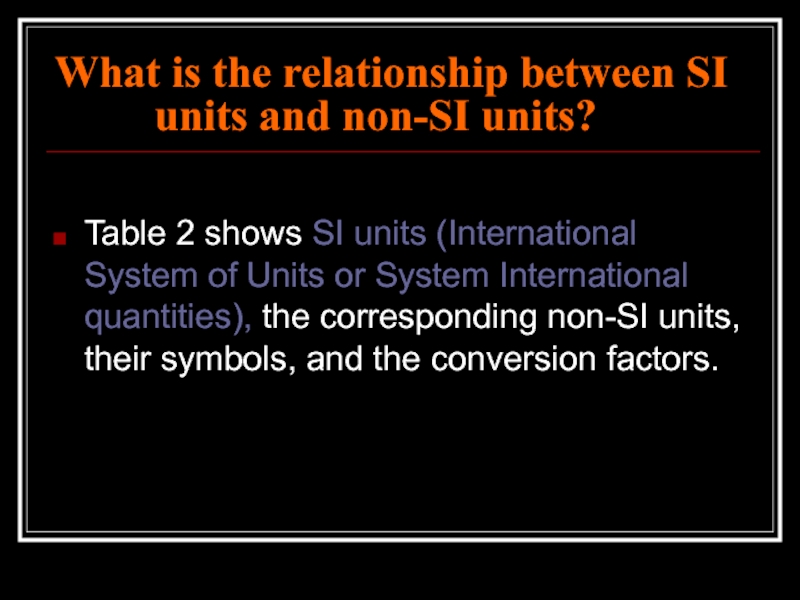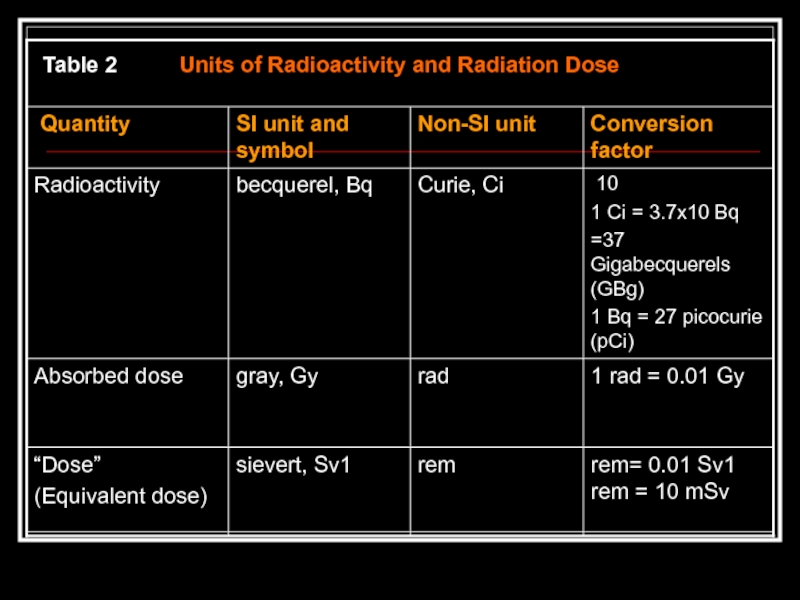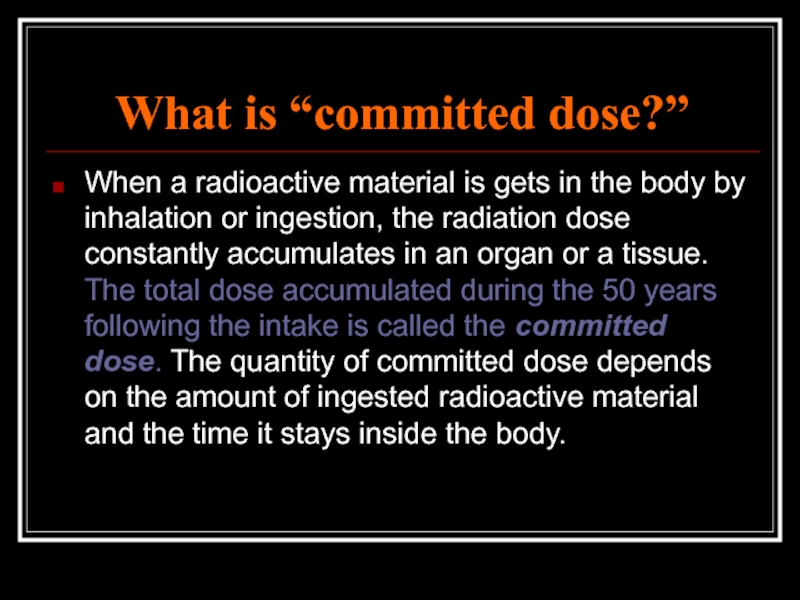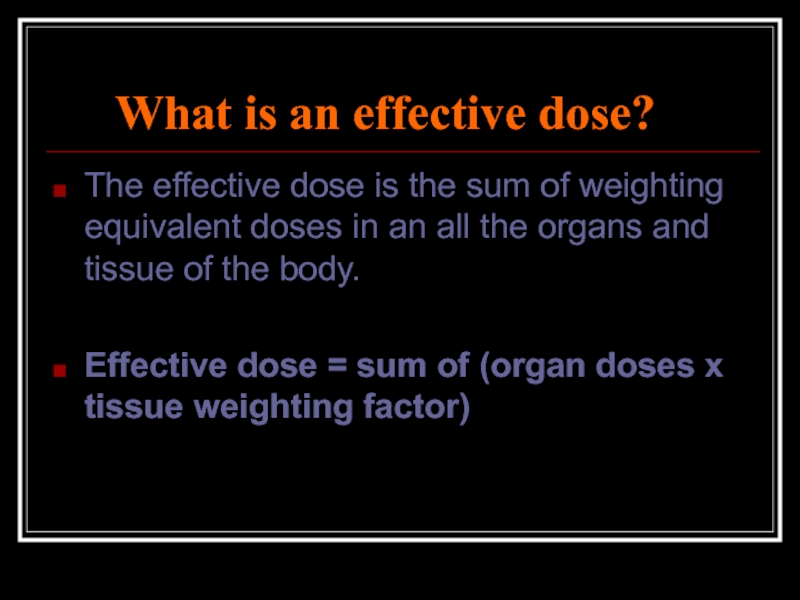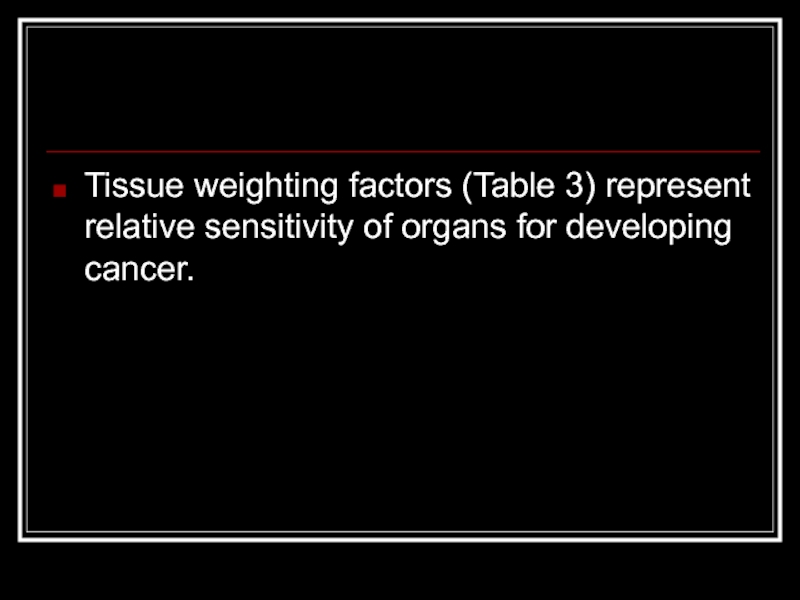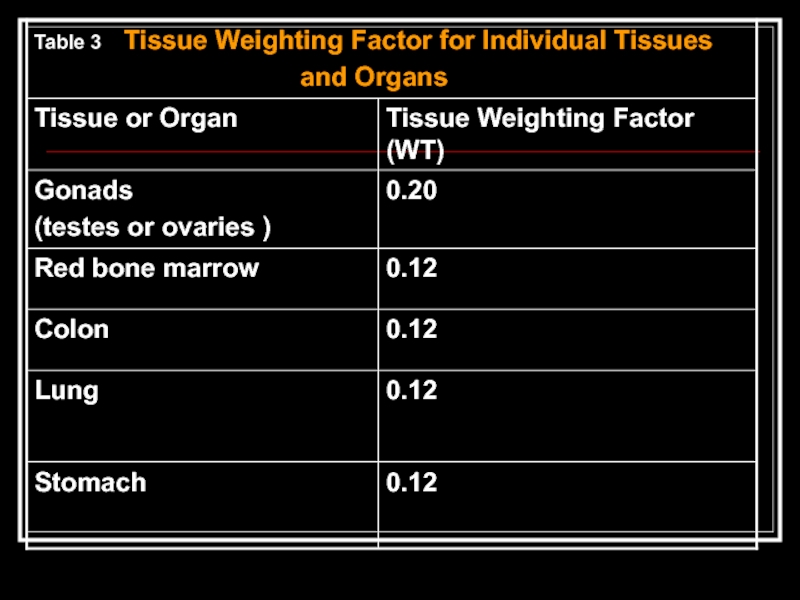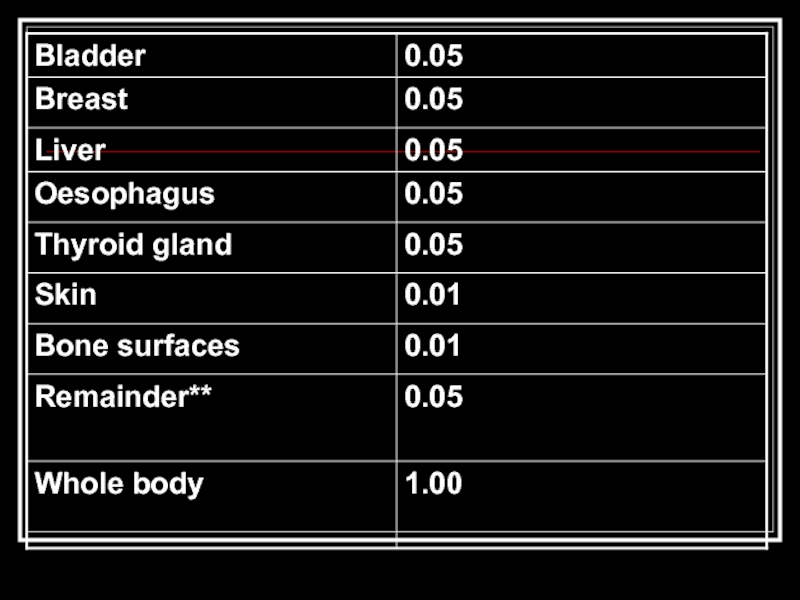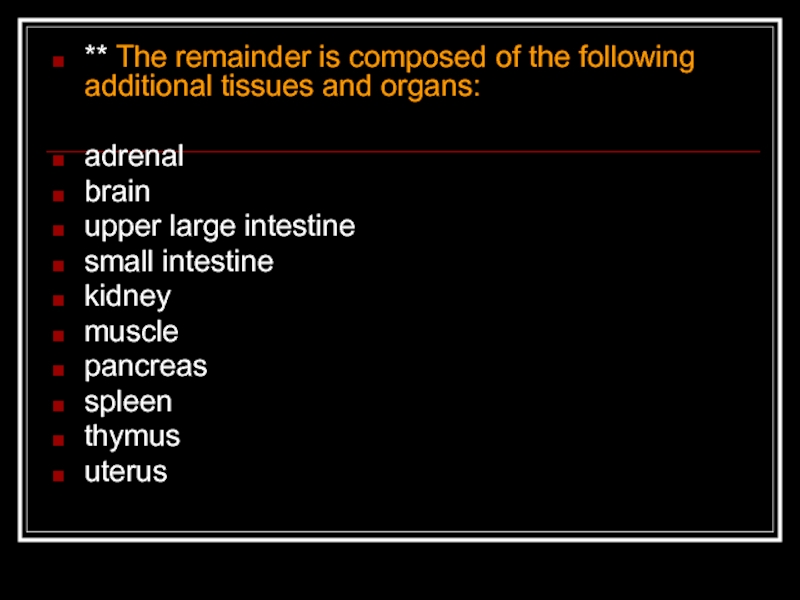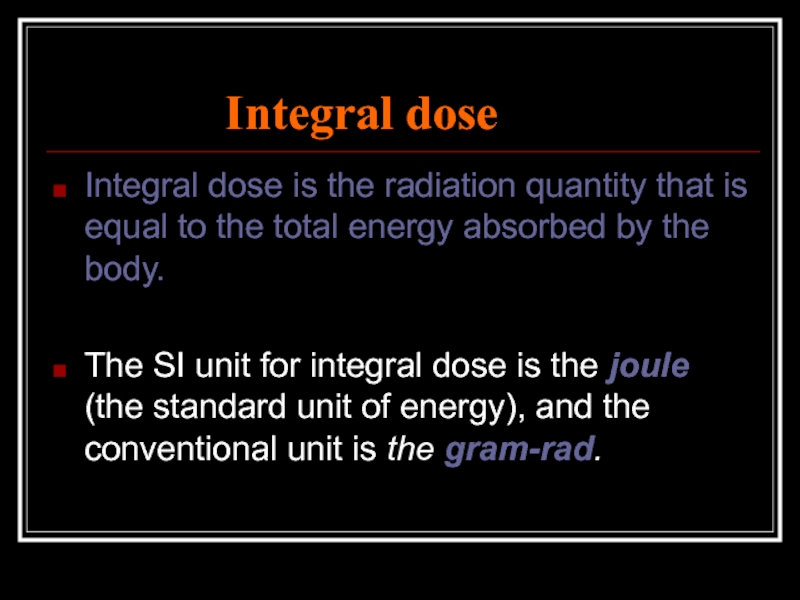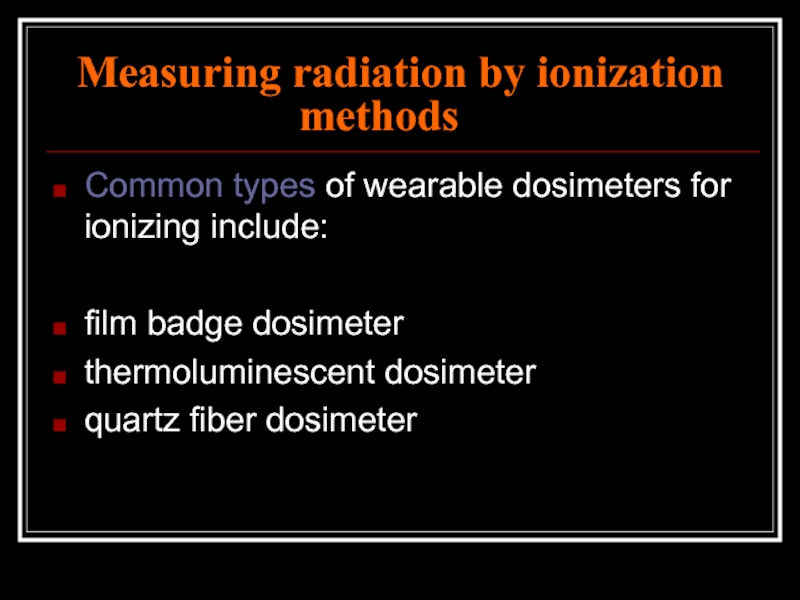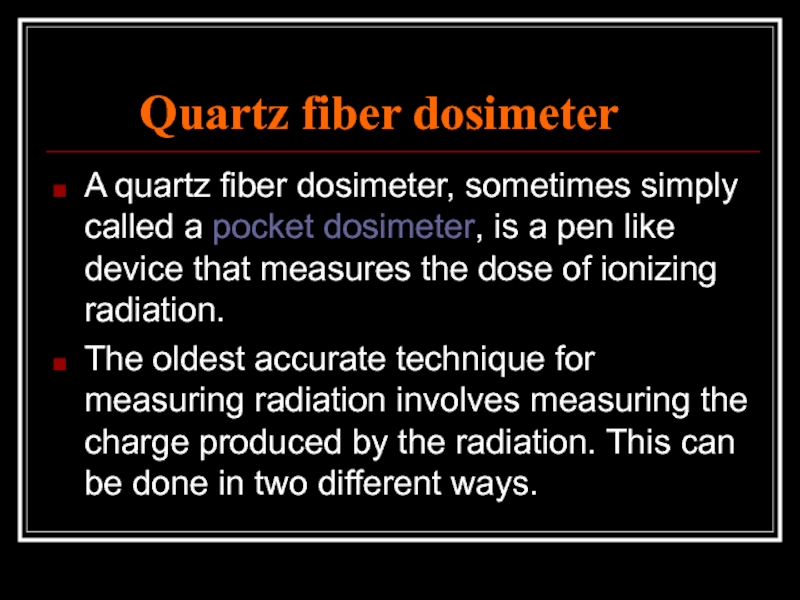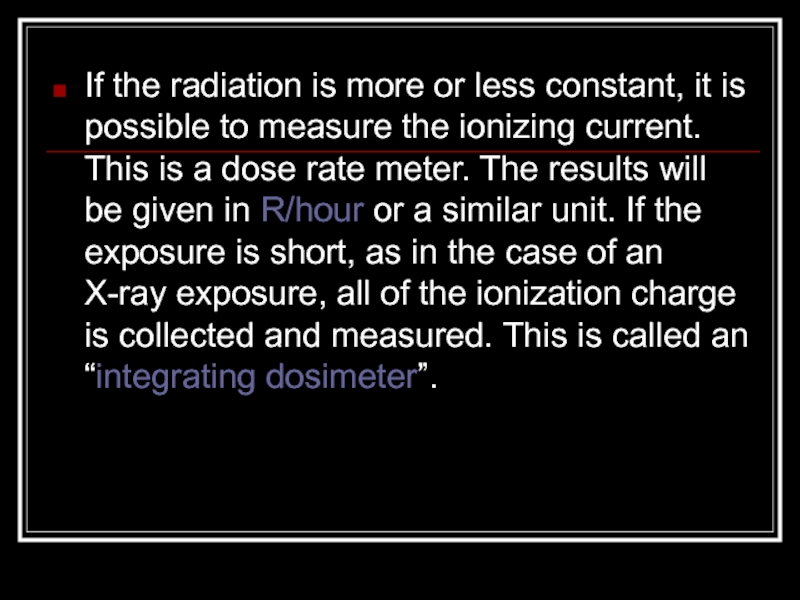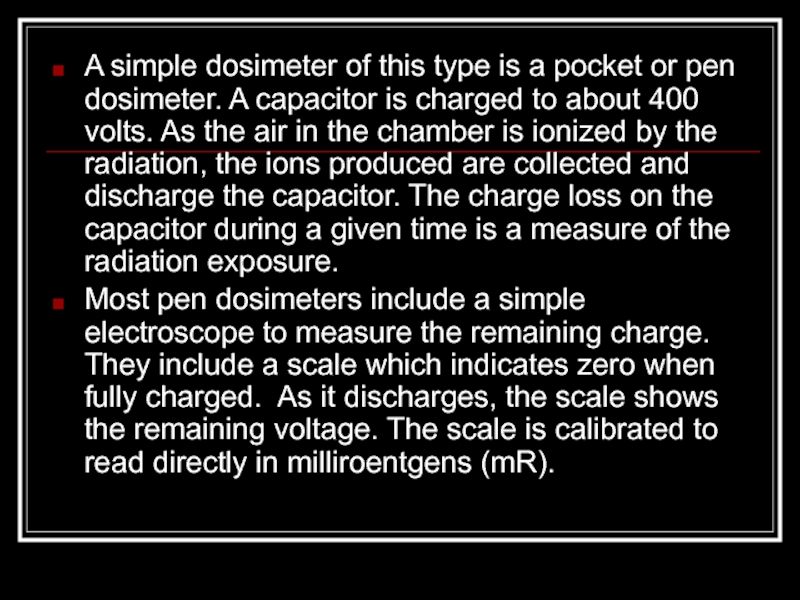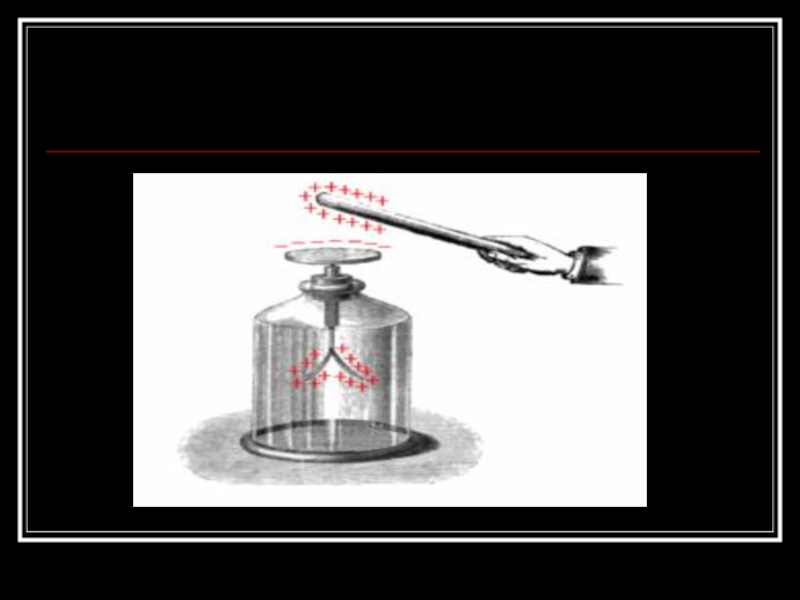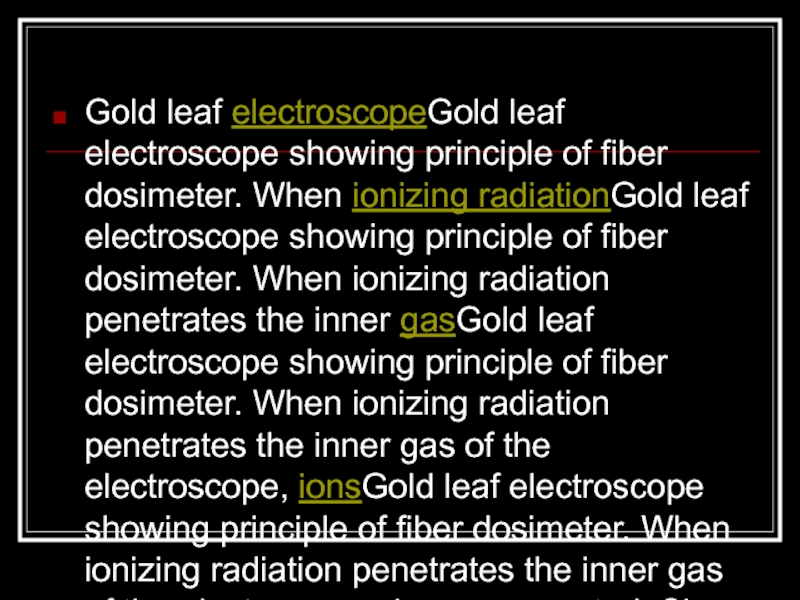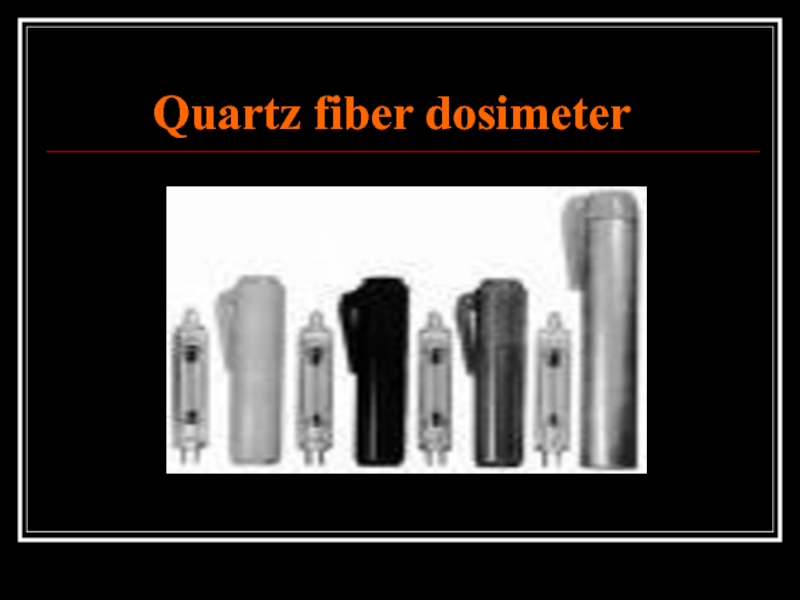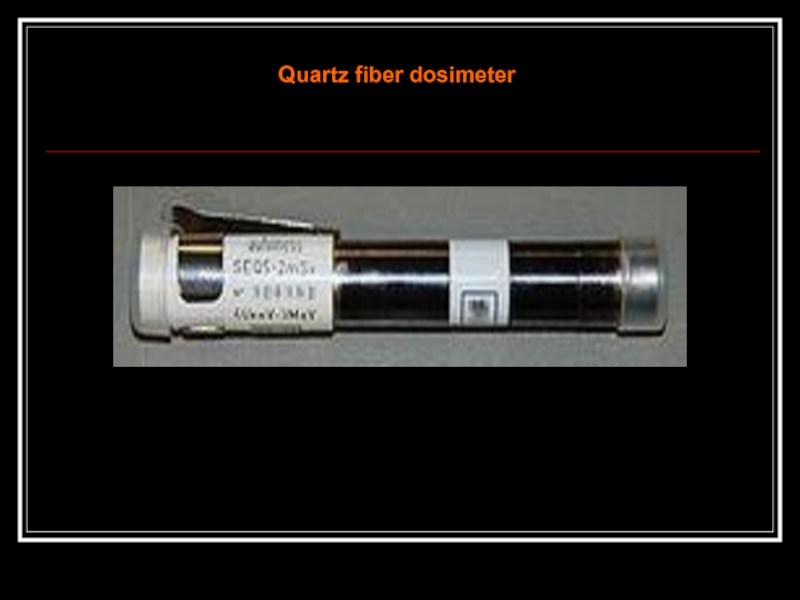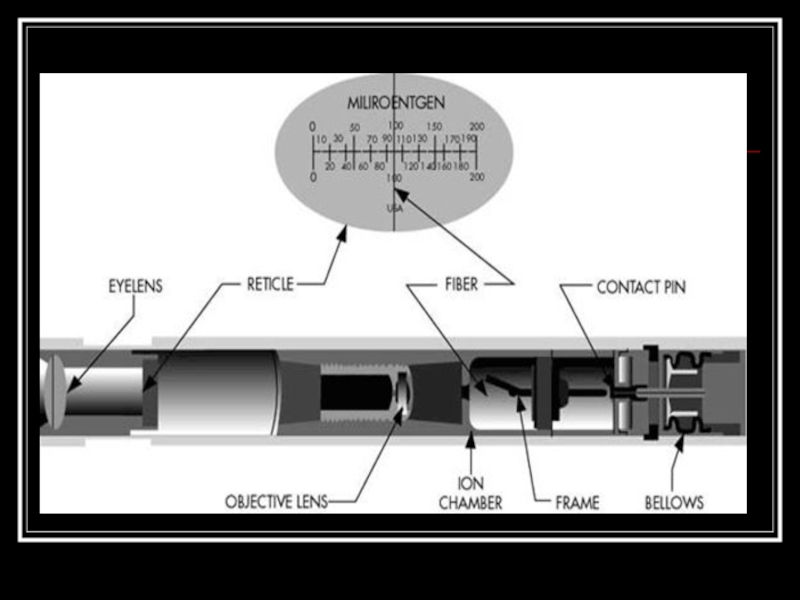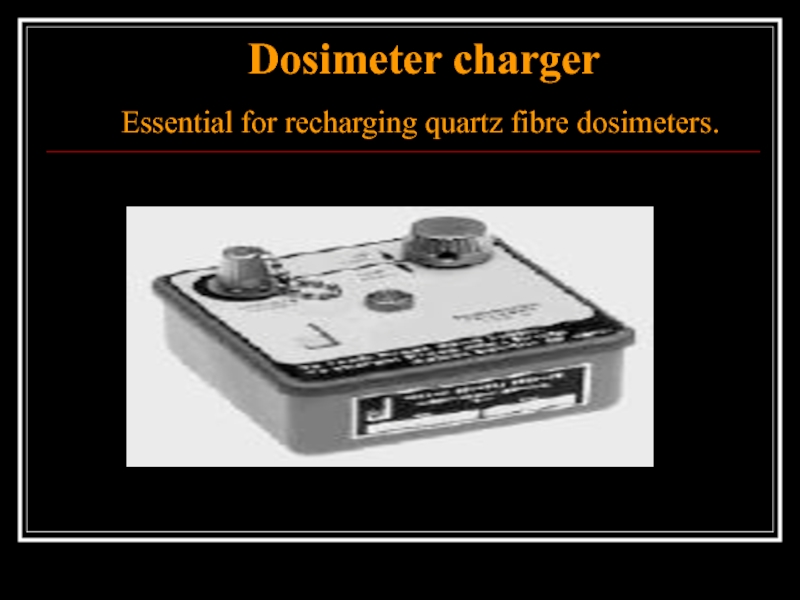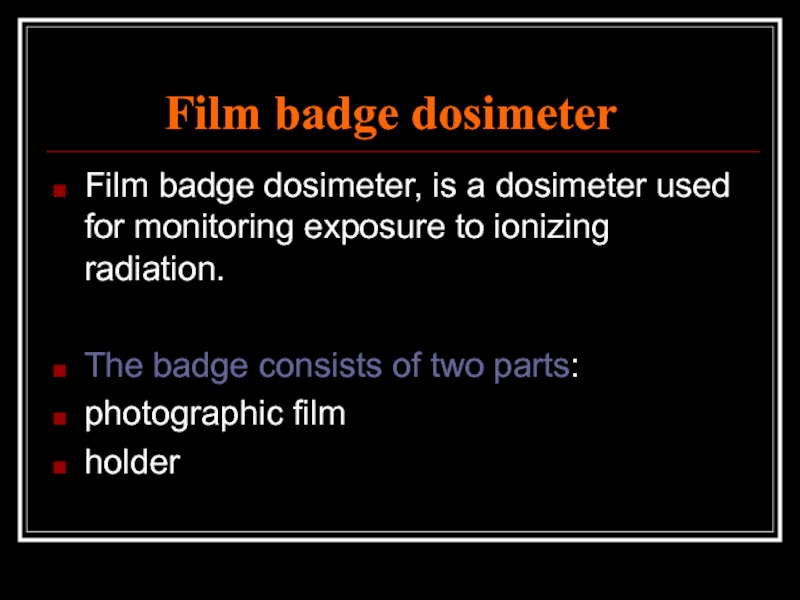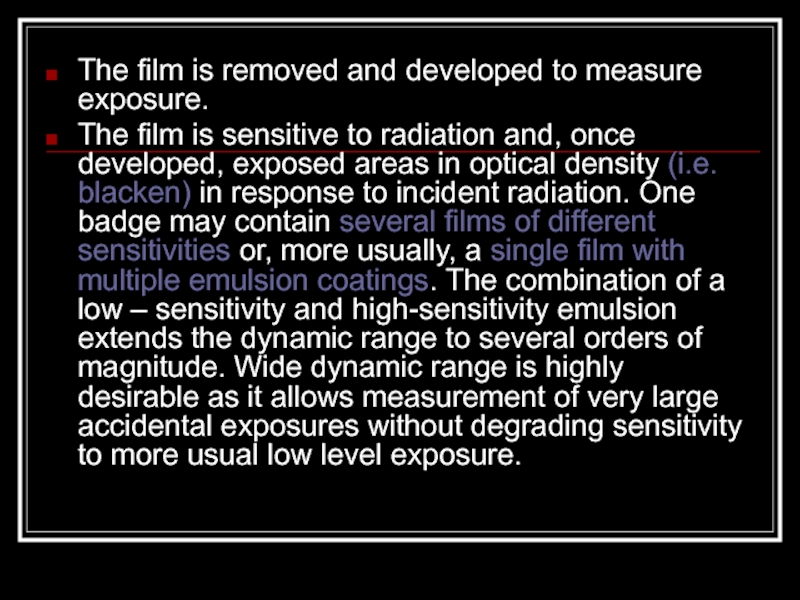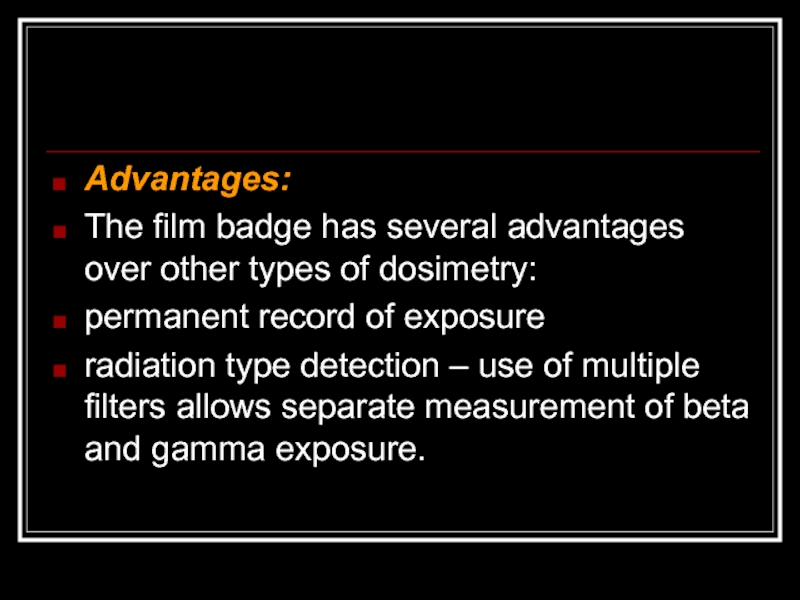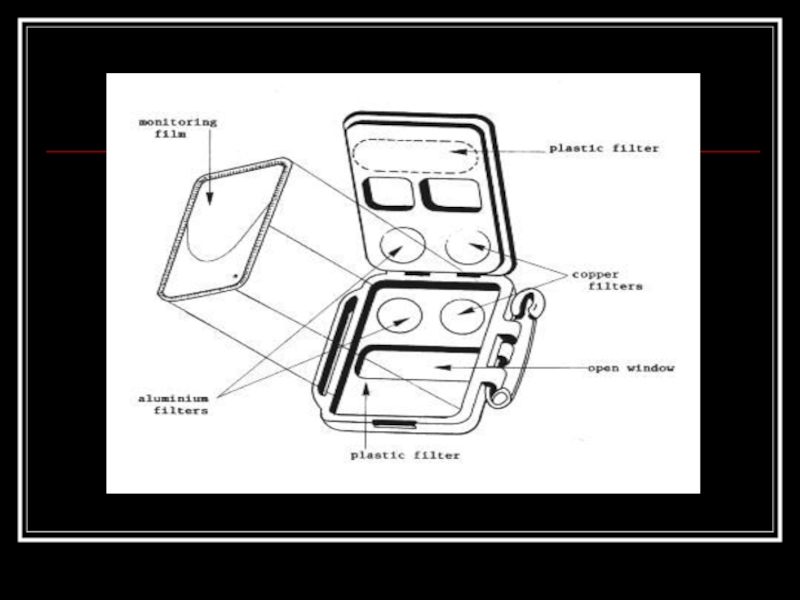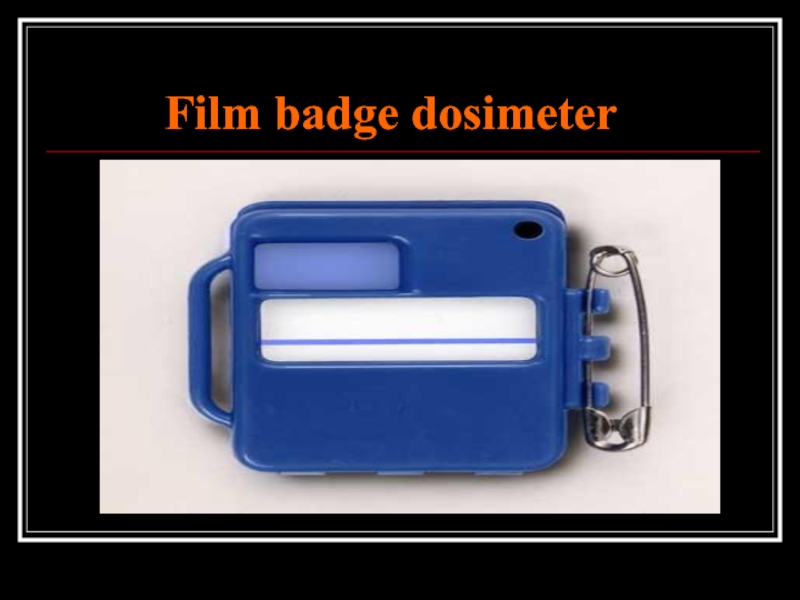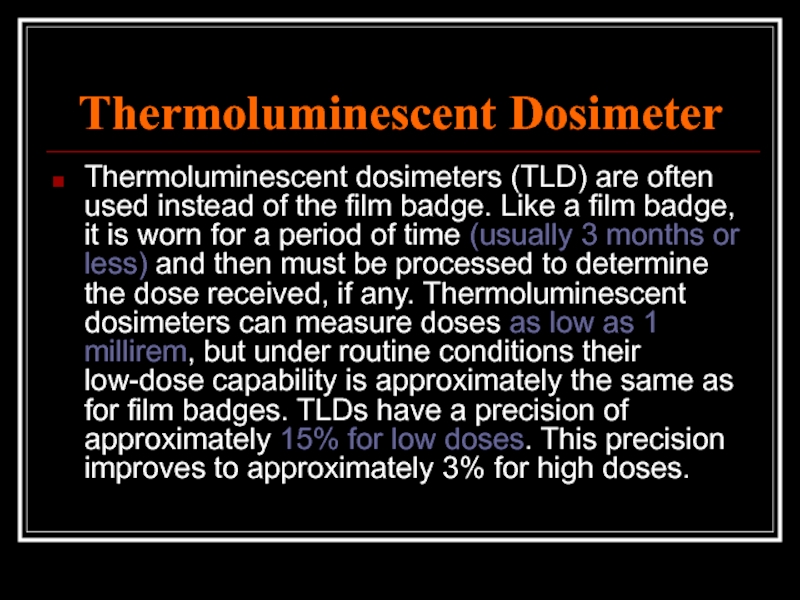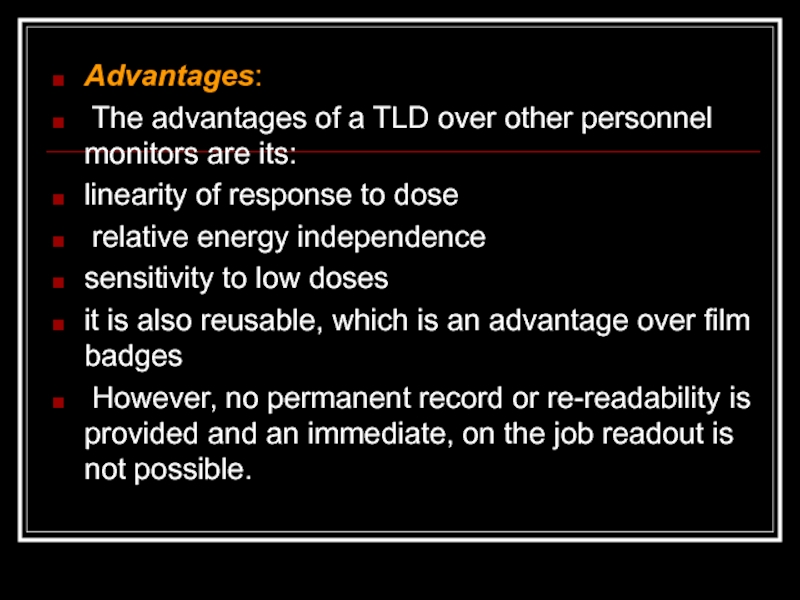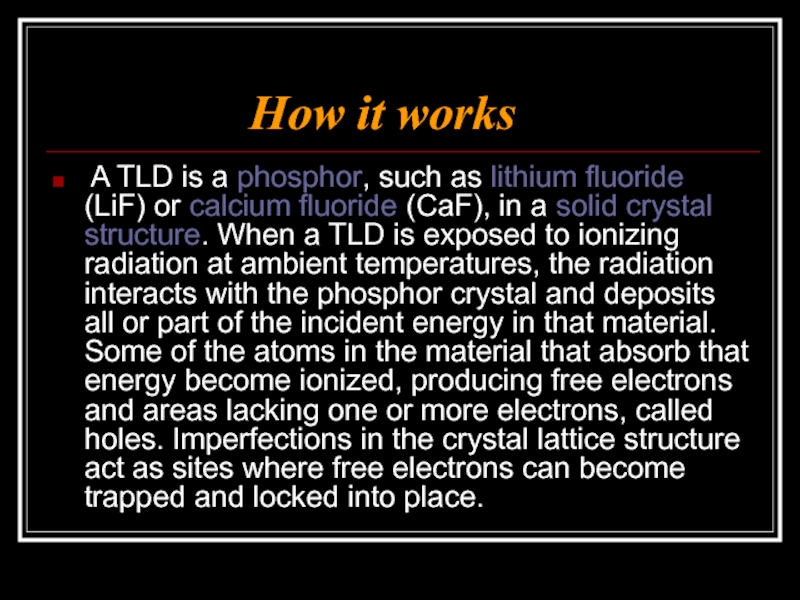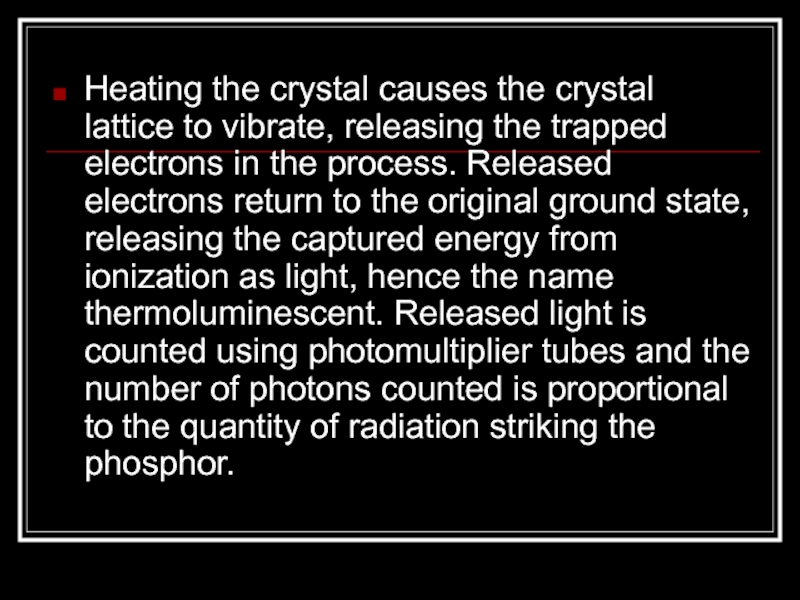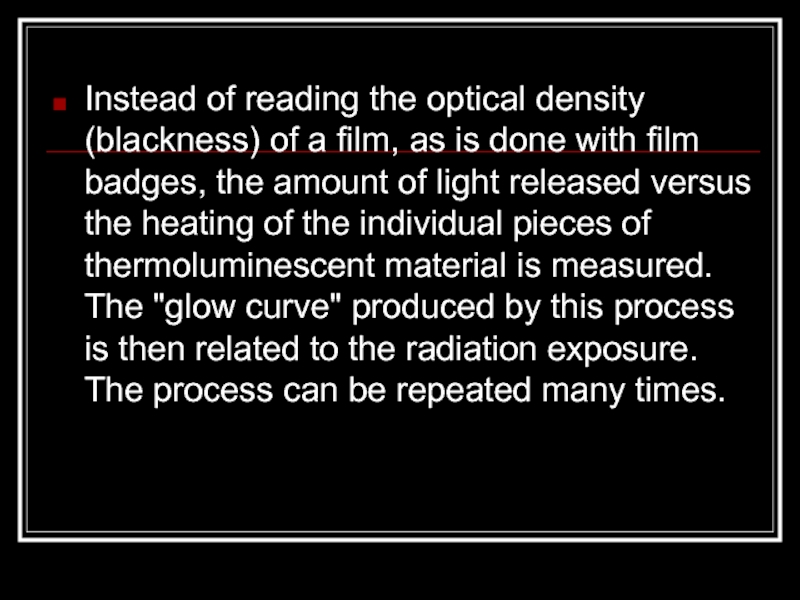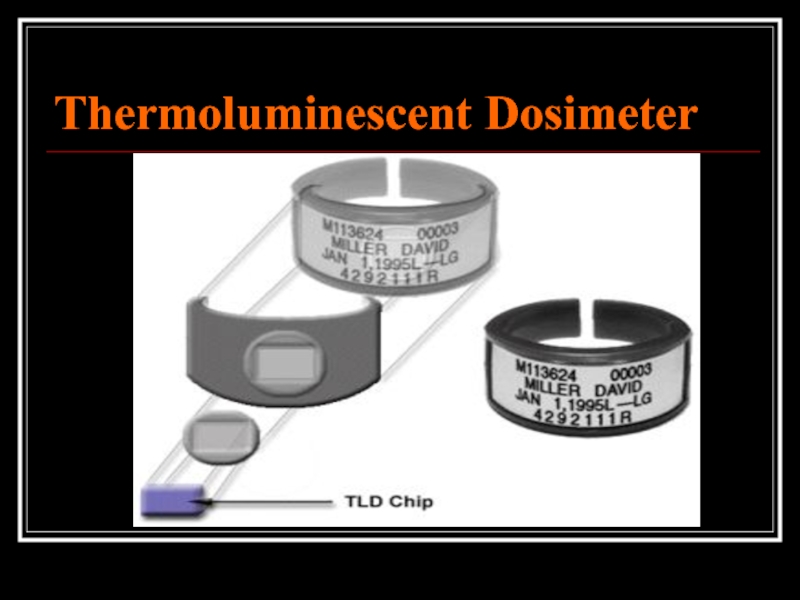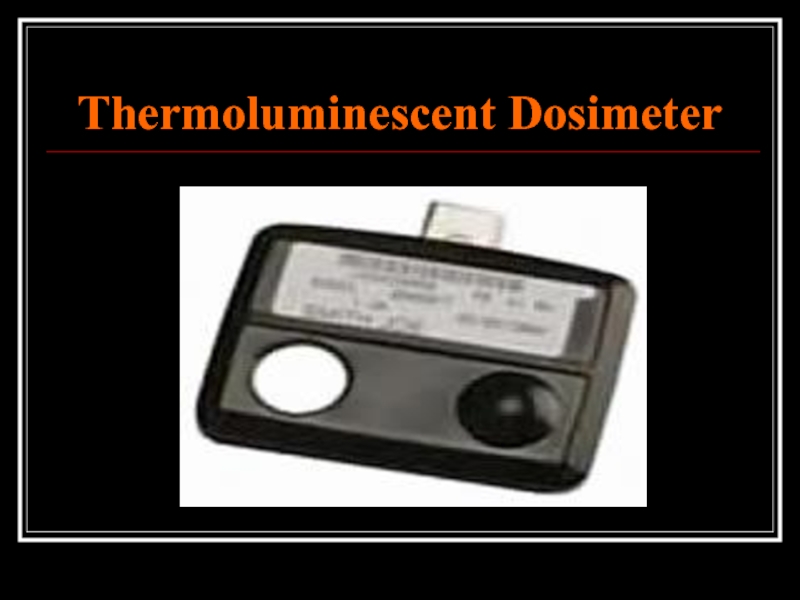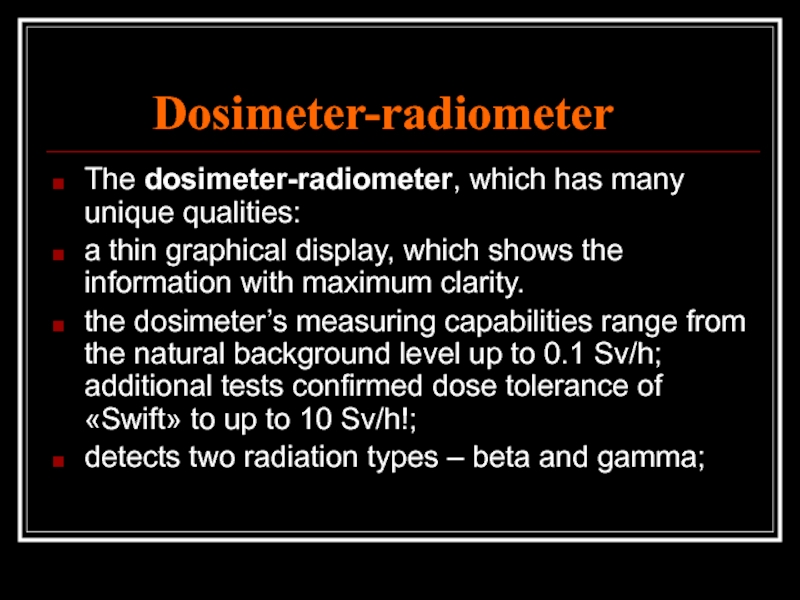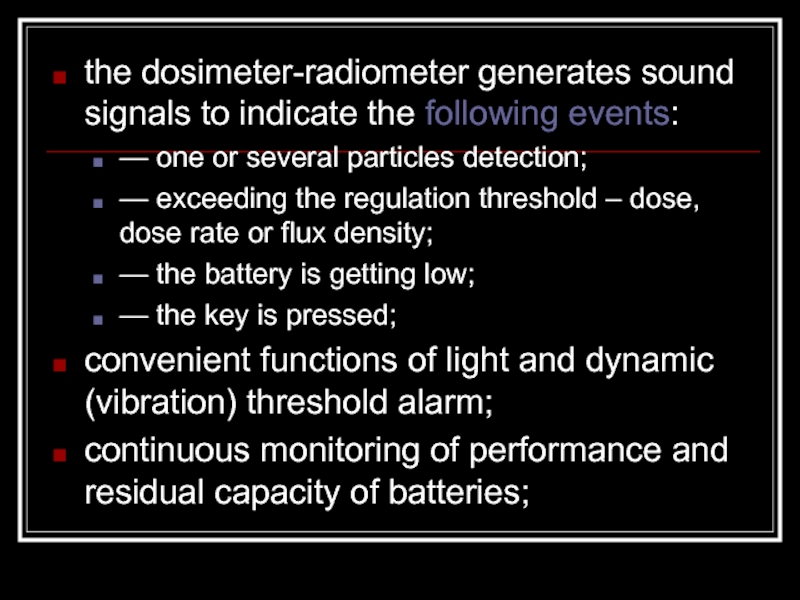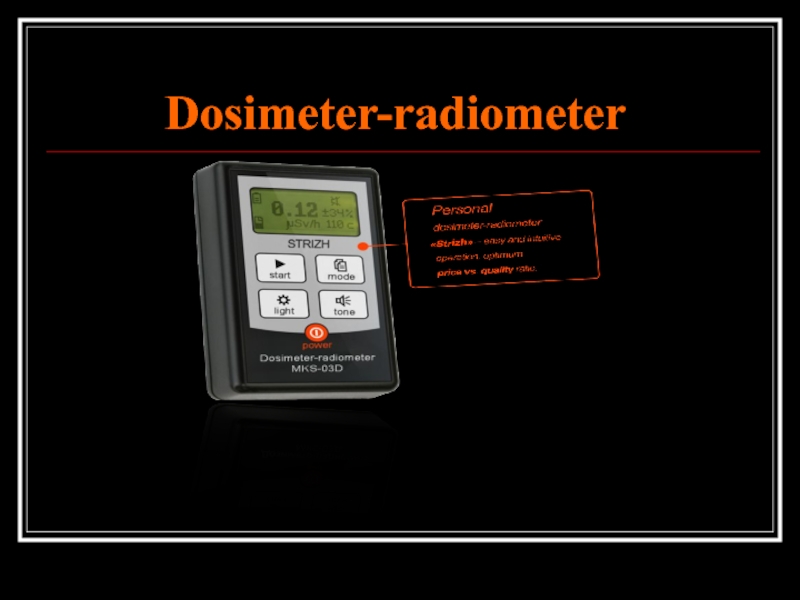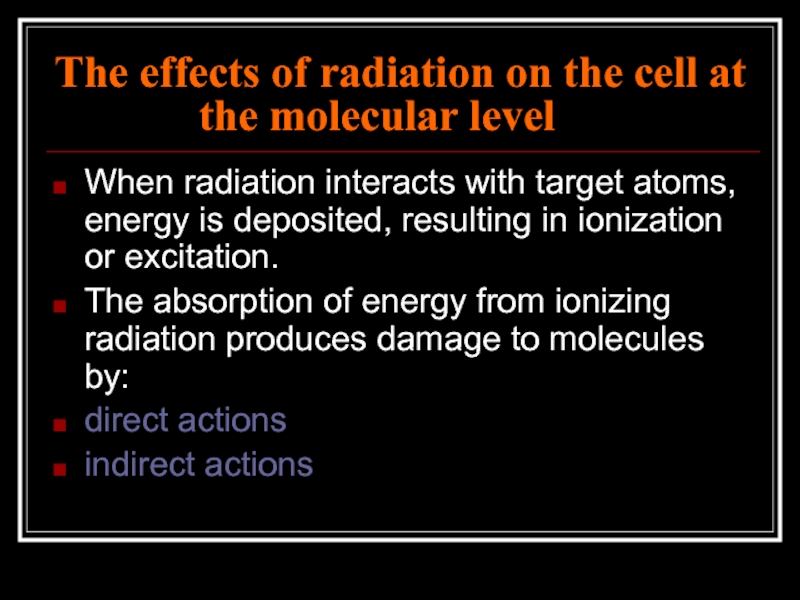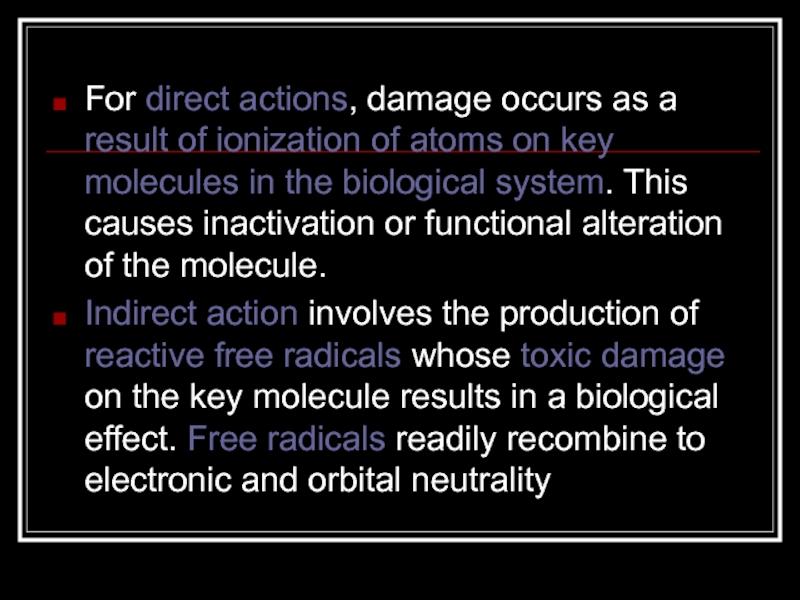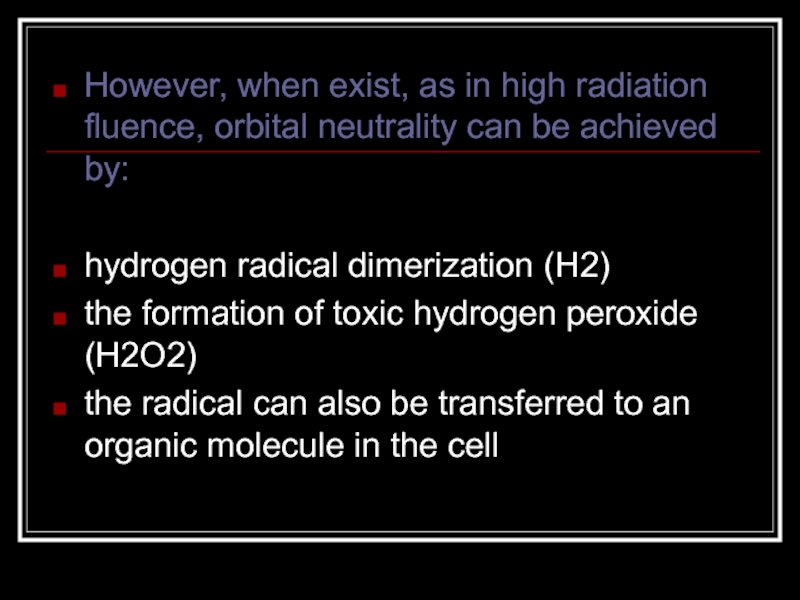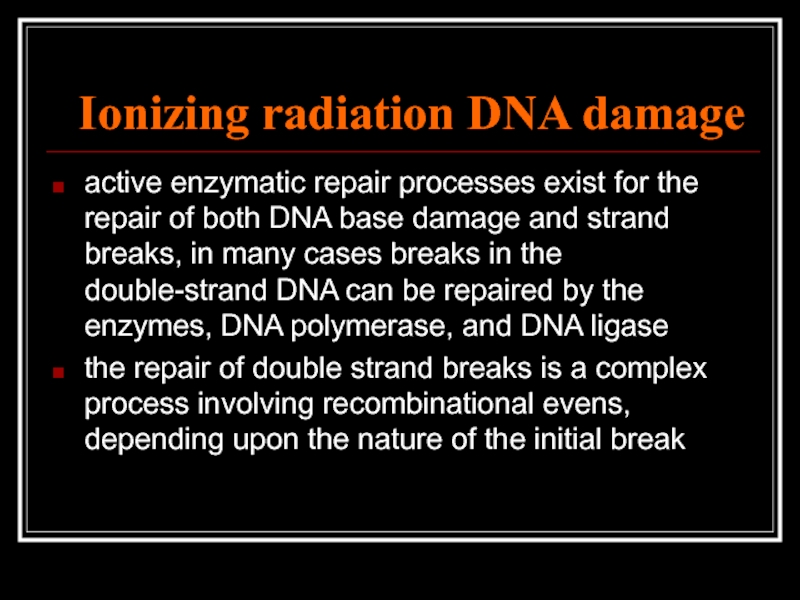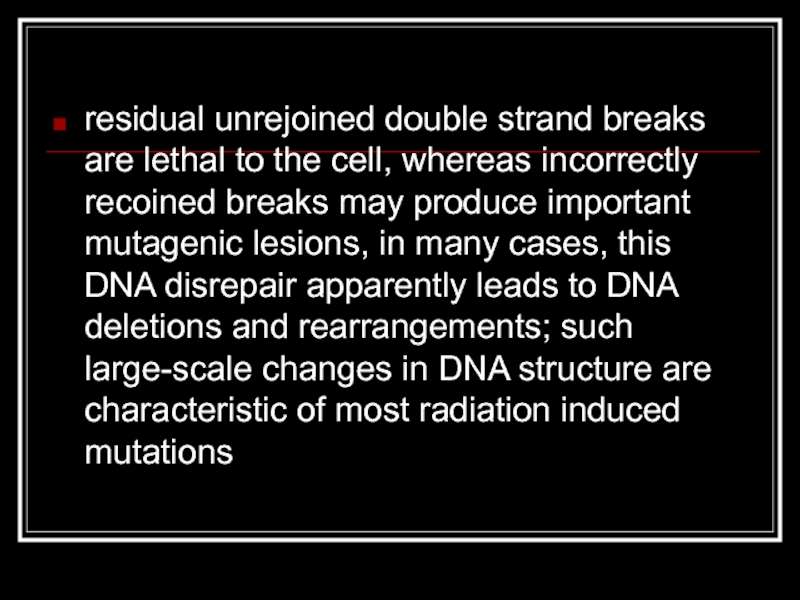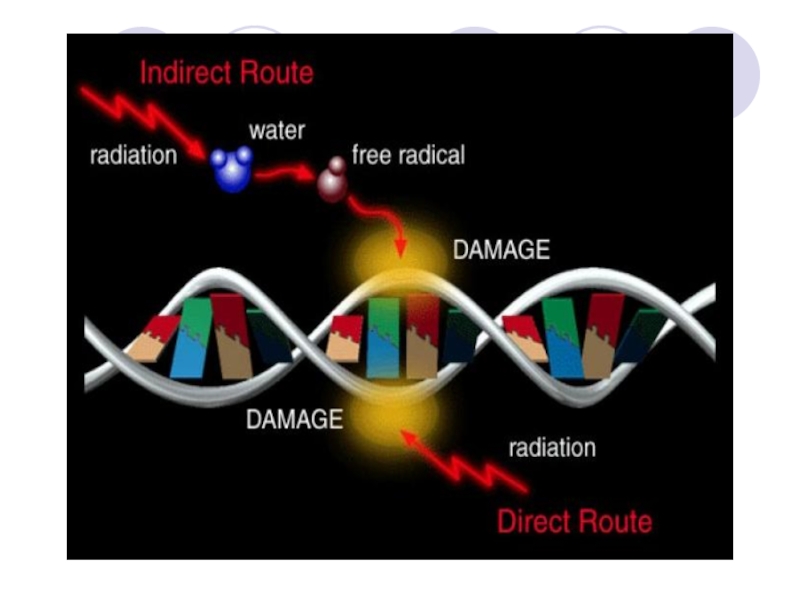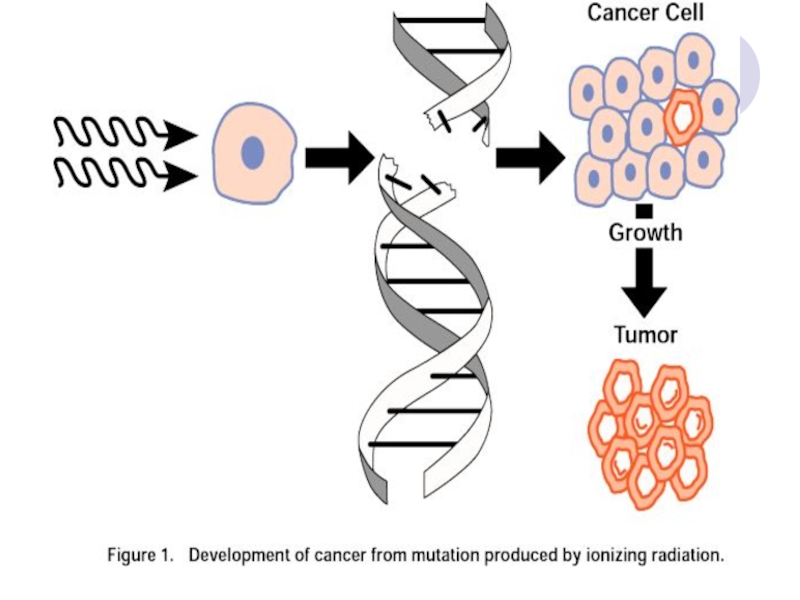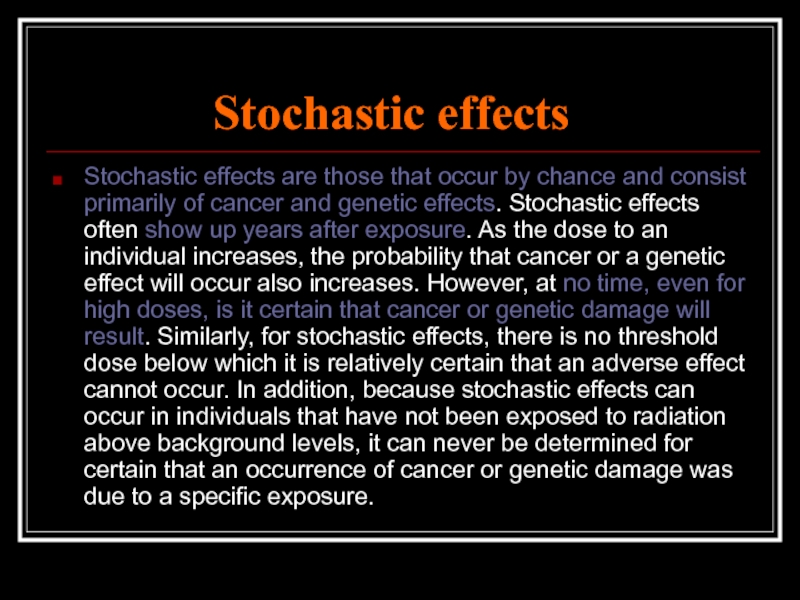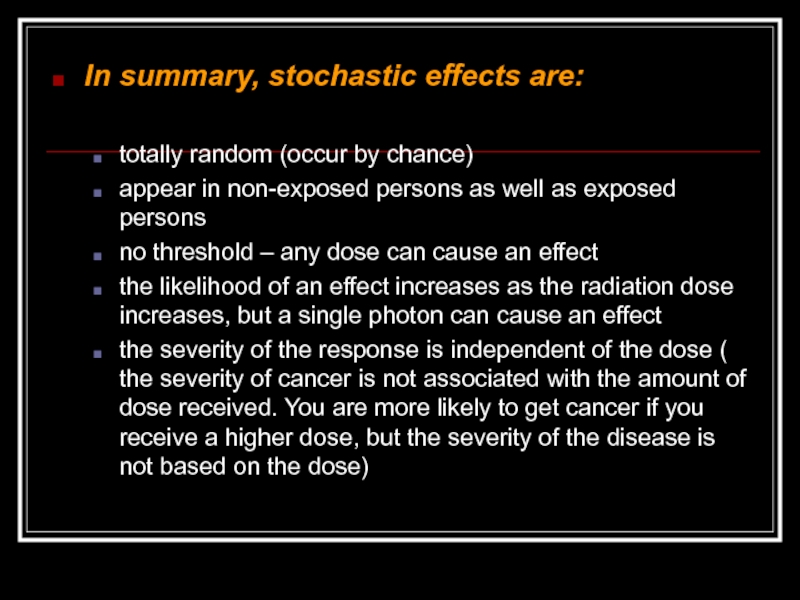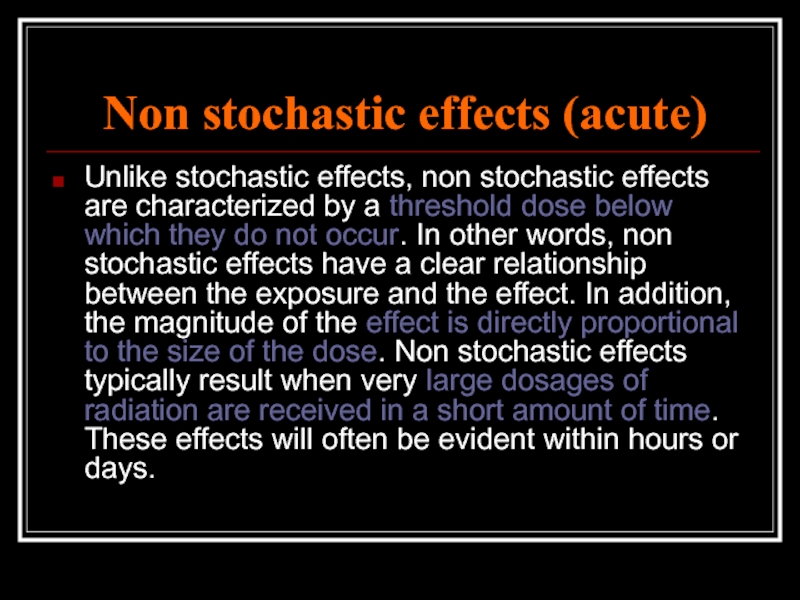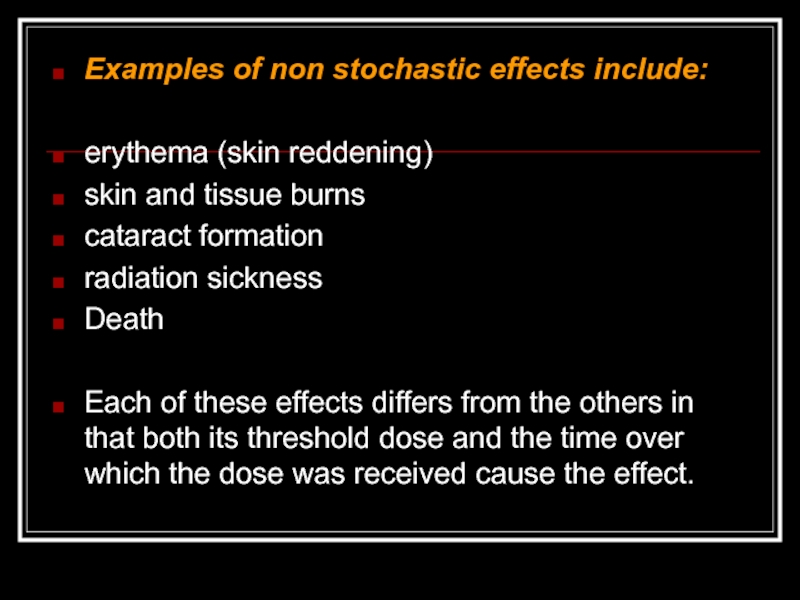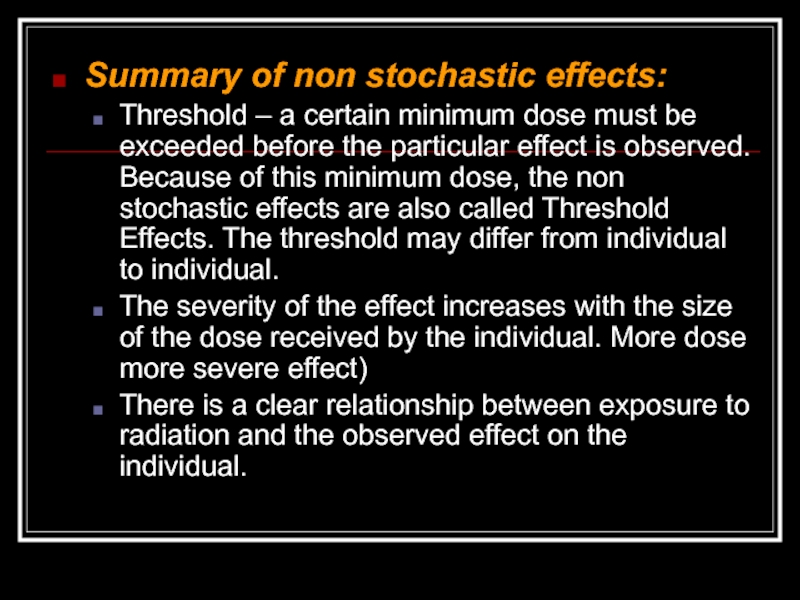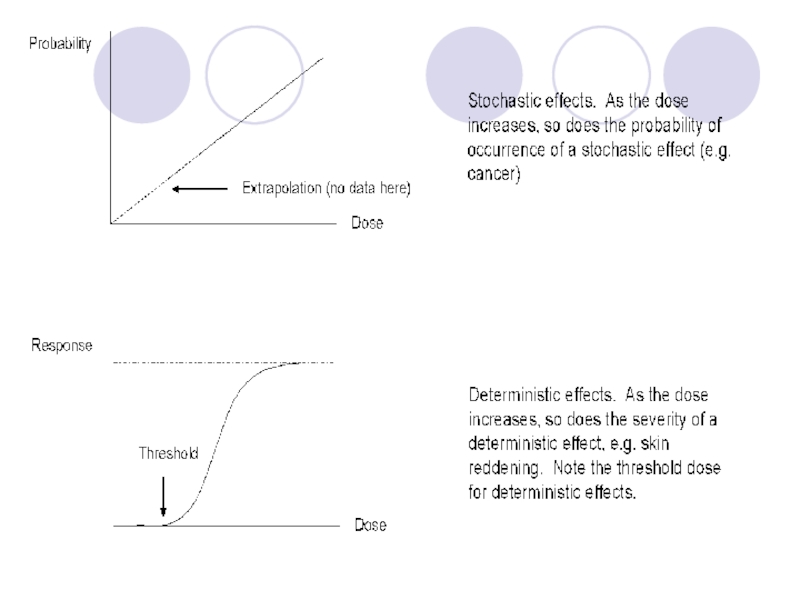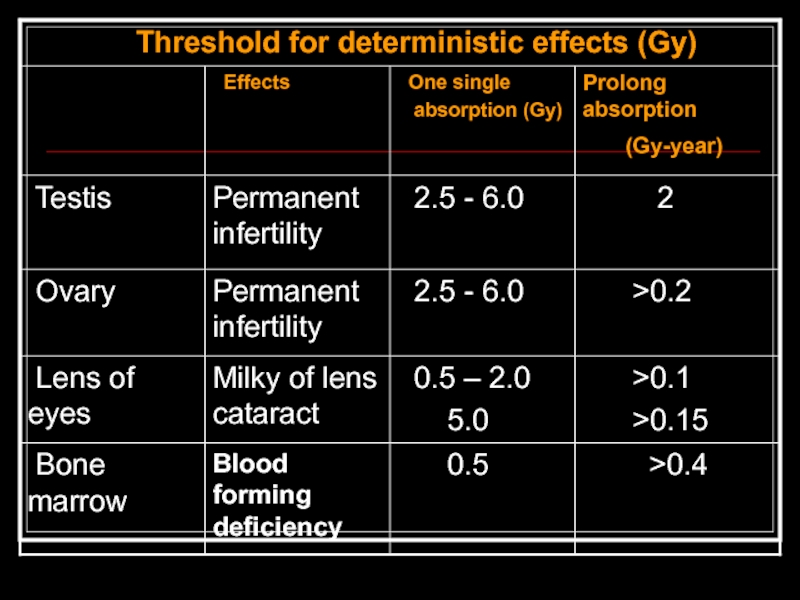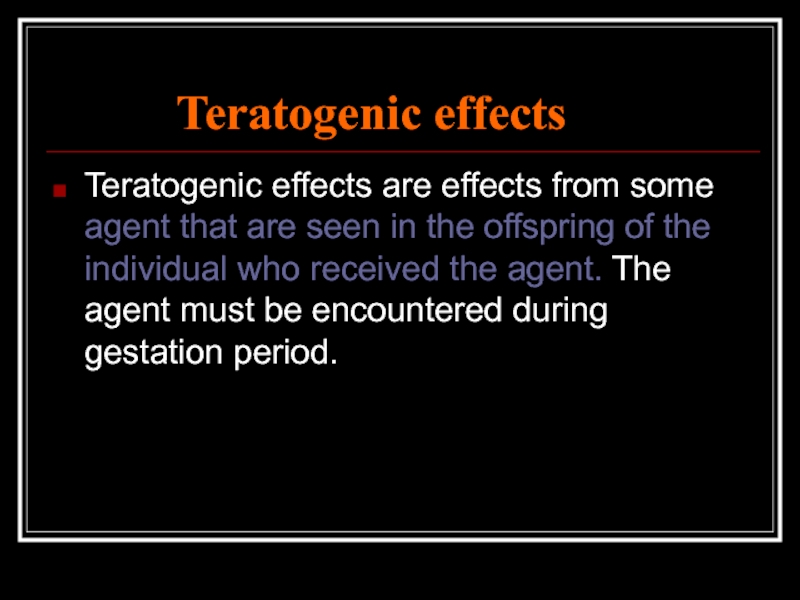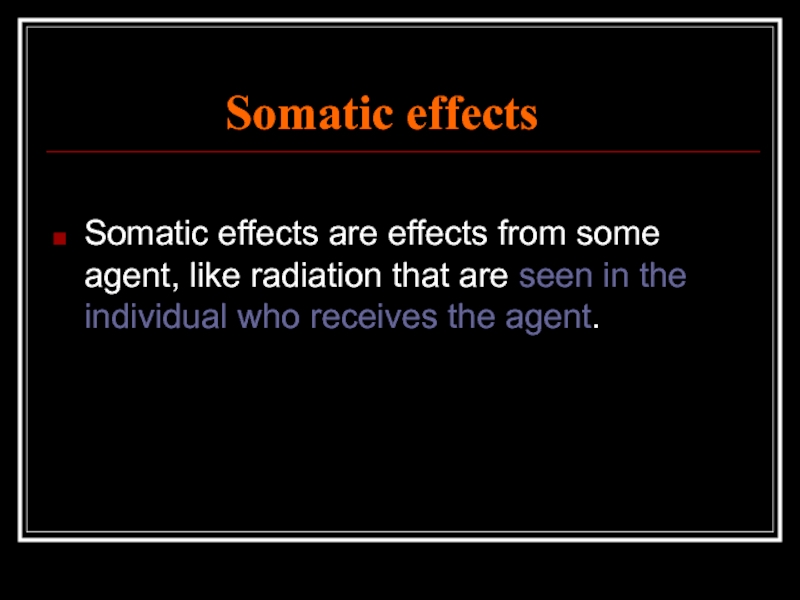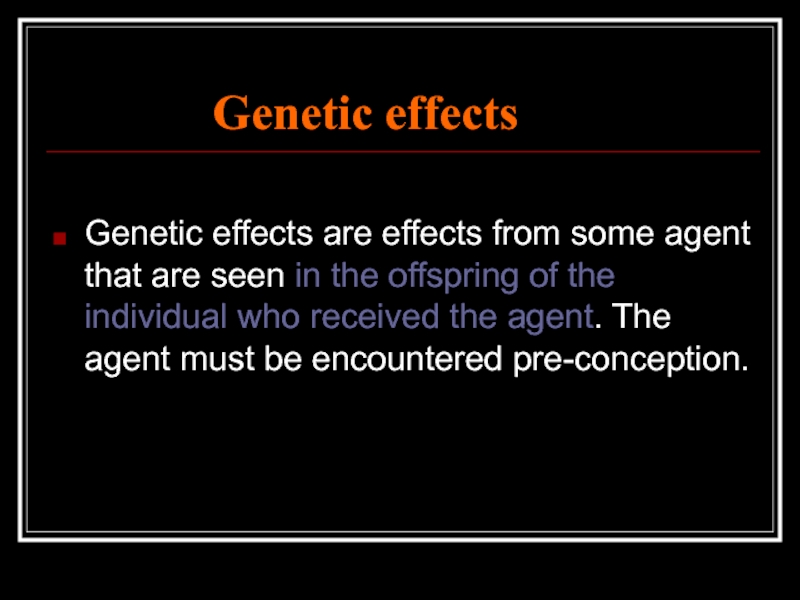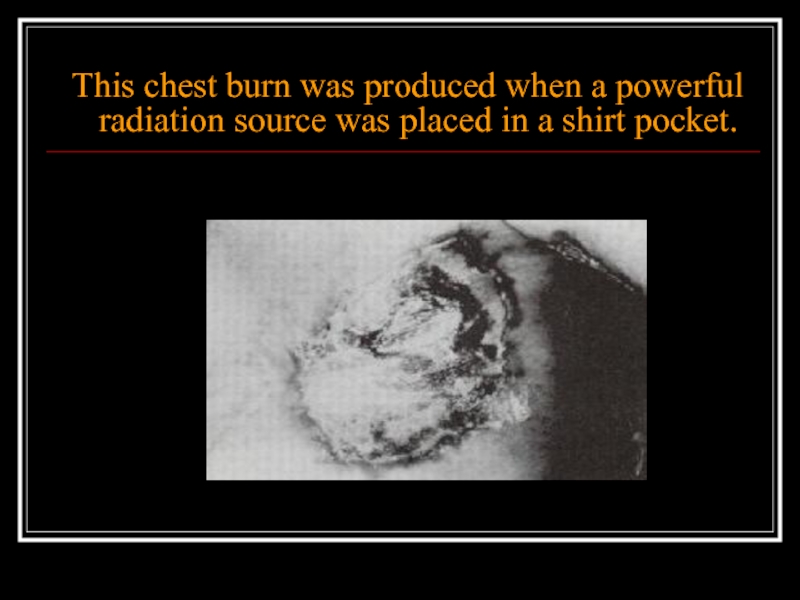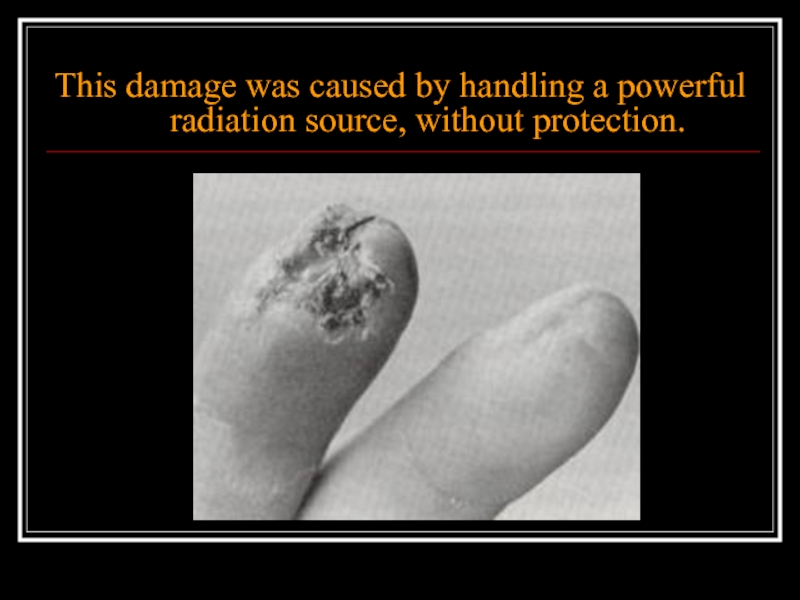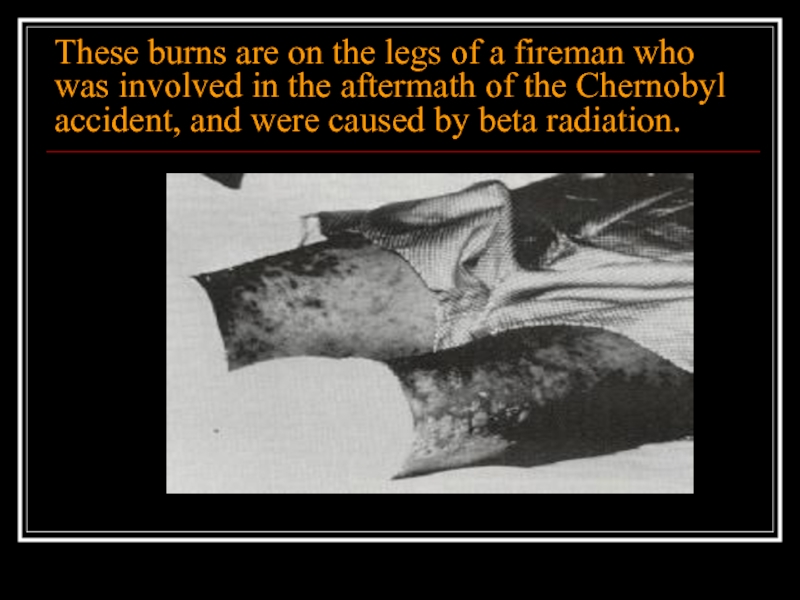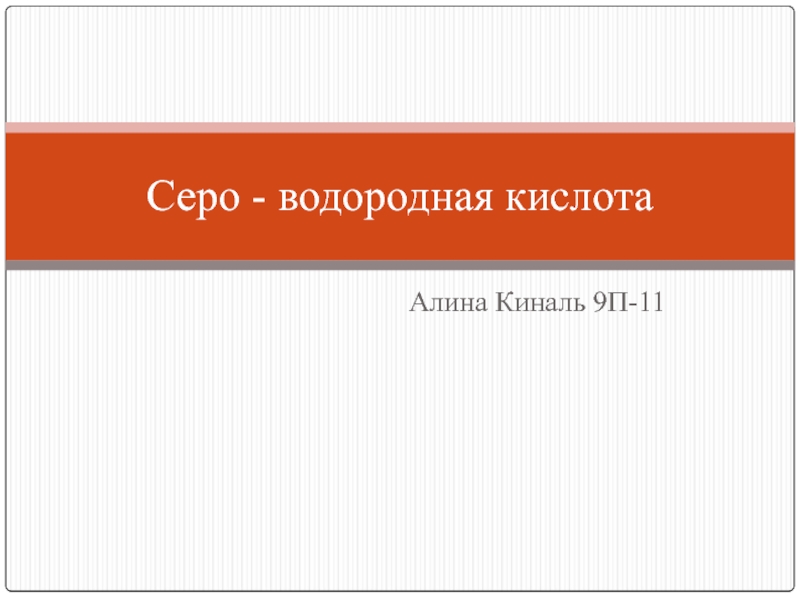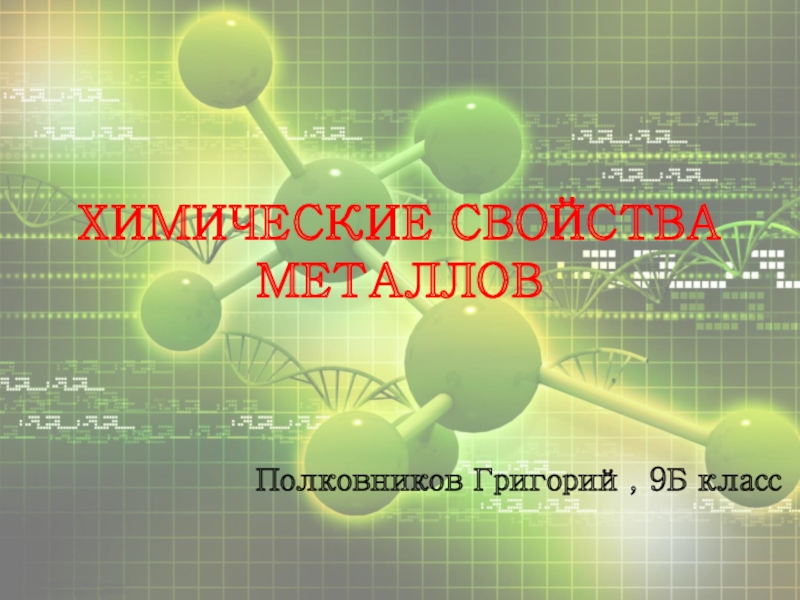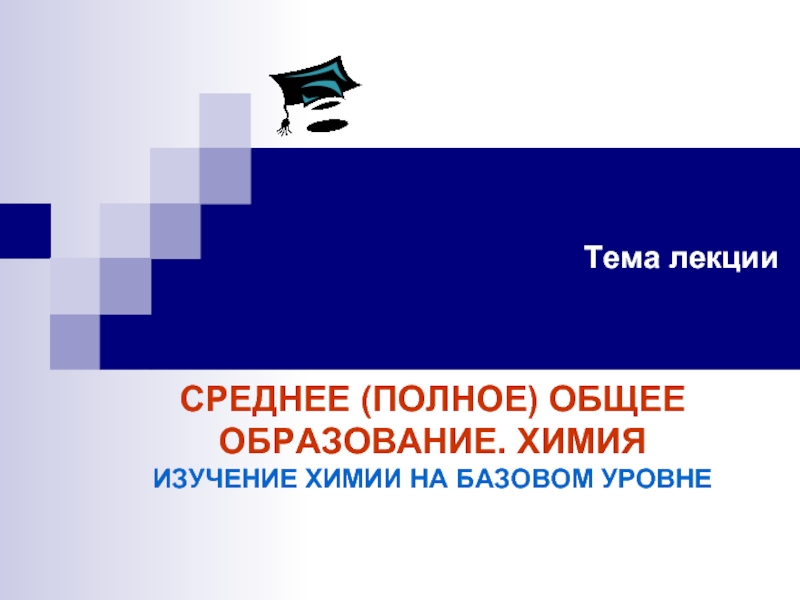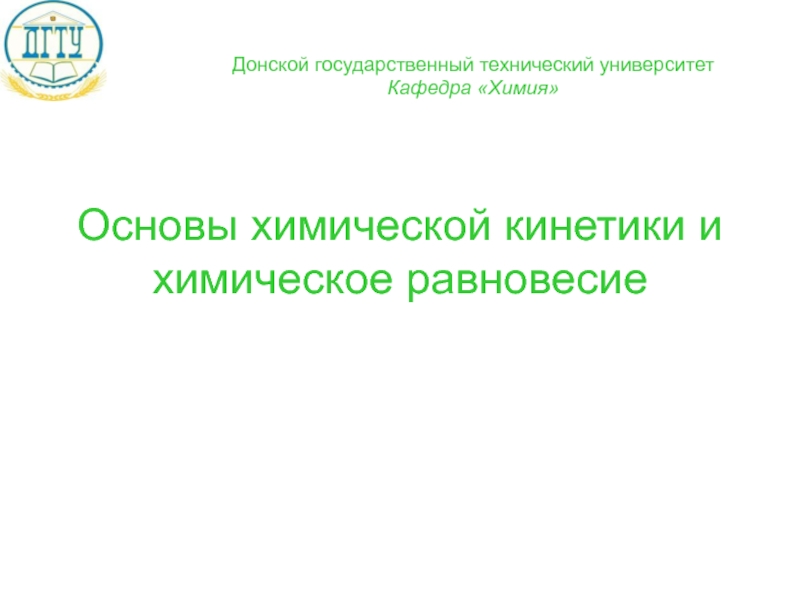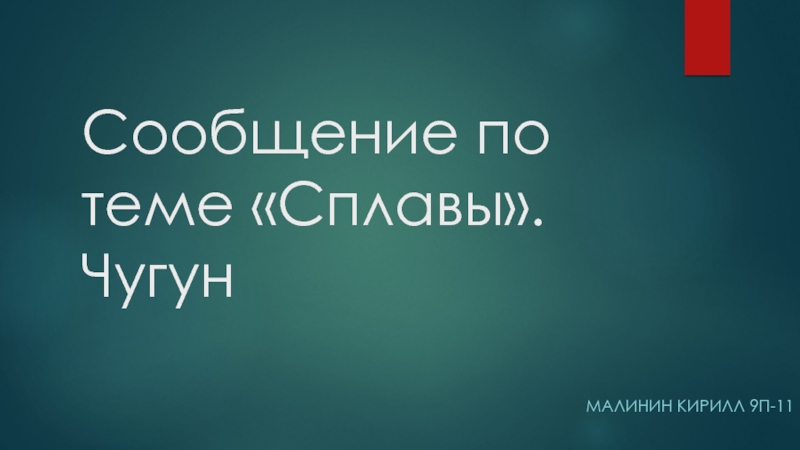- Главная
- Разное
- Дизайн
- Бизнес и предпринимательство
- Аналитика
- Образование
- Развлечения
- Красота и здоровье
- Финансы
- Государство
- Путешествия
- Спорт
- Недвижимость
- Армия
- Графика
- Культурология
- Еда и кулинария
- Лингвистика
- Английский язык
- Астрономия
- Алгебра
- Биология
- География
- Детские презентации
- Информатика
- История
- Литература
- Маркетинг
- Математика
- Медицина
- Менеджмент
- Музыка
- МХК
- Немецкий язык
- ОБЖ
- Обществознание
- Окружающий мир
- Педагогика
- Русский язык
- Технология
- Физика
- Философия
- Химия
- Шаблоны, картинки для презентаций
- Экология
- Экономика
- Юриспруденция
Radiation dosimetry презентация
Содержание
- 1. Radiation dosimetry
- 2. Radiation quantities and units The basic
- 3. Exposure = ionization air
- 4. Absorbed dose = energy/mass When
- 5. One gray dose is equivalent to one
- 6. Equivalent
- 7. To account for this difference, radiation dose
- 9. Equivalent dose is often referred to
- 10. 1Sv = 100 rem 1 rem
- 11. What effects do different doses of
- 12. Here are some examples: 10
- 13. What are the limits of
- 14. What is the relationship between SI
- 16. What is “committed dose?”
- 17. What is an effective
- 18. Tissue weighting factors (Table 3) represent relative sensitivity of organs for developing cancer.
- 21. ** The remainder is composed of the
- 23. Measuring radiation by ionization
- 24. Quartz fiber dosimeter
- 25. If the radiation is more or less
- 26. A simple dosimeter of this type is
- 28. Gold leaf electroscopeGold leaf electroscope showing principle
- 29. Quartz fiber dosimeter
- 33. Film badge
- 34. The film is removed and developed to
- 35. Advantages: The film badge has several advantages
- 37. Film badge dosimeter
- 38. Thermoluminescent Dosimeter Thermoluminescent dosimeters (TLD) are
- 39. Advantages: The advantages of a TLD
- 41. Heating the crystal causes the crystal lattice
- 42. Instead of reading the optical density (blackness)
- 43. Thermoluminescent Dosimeter
- 44. Thermoluminescent Dosimeter
- 45. Dosimeter-radiometer The dosimeter-radiometer,
- 46. the dosimeter-radiometer generates sound signals to indicate
- 47. Dosimeter-radiometer
- 48. The effects of radiation on the cell
- 49. For direct actions, damage occurs as a
- 50. However, when exist, as in high radiation
- 51. Ionizing radiation DNA damage active enzymatic
- 52. residual unrejoined double strand breaks are lethal
- 56. In summary, stochastic effects are: totally
- 57. Non stochastic effects (acute) Unlike
- 58. Examples of non stochastic effects include:
- 59. Summary of non stochastic effects: Threshold –
- 62. Teratogenic effects
- 65. This chest burn was produced when
- 66. This damage was caused by handling a
- 67. These burns are on the legs of
Слайд 2 Radiation quantities and units
The basic radiation quantities are:
exposure dose
absorbed dose
equivalent
effective dose
integral dose
Слайд 3 Exposure = ionization air
The old unit to measure
-4
where 1R=2.58 x 10 C/kg
Слайд 4 Absorbed dose = energy/mass
When ionizing radiation interacts with the
Слайд 5One gray dose is equivalent to one joule radiation energy absorbed
Rad is the old and still used of absorbed dose.
One gray is equivalent to 100 rads.
1Gy =100 rads
Слайд 6 Equivalent dose
The third important radiation
Equal doses of all types of ionizing radiation are not equally harmful. Alpha particles produce greater harm than do beta particles, gamma rays and x rays for a given absorbed dose.
Слайд 7To account for this difference, radiation dose is expressed as equivalent
The dose in SV is equal to “absorbed dose” multiplied by a “radiation weighting factor” (Wr – see table 1 below). Prior to 1990, this weighting factor was referred to as Quality Factor (QF).
Слайд 9
Equivalent dose is often referred to simply as “dose” in energy
Dose in Sv = Absorbed Dose in Gy x radiation weighting factor (WR)
Dose in rem = Dose in rad x QF
Слайд 10
1Sv = 100 rem
1 rem = 10 mSv (millisievert = one
1Gy air dose equivalent to 0.7 Sv tissue dose
1 R (roentgen) exposure is approximately equivalent to 10 mSv tissue dose
Слайд 11 What effects do different doses of
One sievert is a large dose. The recommended Threshold Limit Values (TLV) is average dose of 0.05 Sv (50 mSv).
The effects of being exposed to large doses of radiation at one time (acute exposure) vary with the dose.
Слайд 12
Here are some examples:
10 Sv – Risk of death within days
1 Sv – Risk of cancer later in life (5 in 100)
100 mSv – Risk of cancer later in life (5 in 1000)
50 mSv – TLV annual dose for radiation workers in any one year
20 mSv – TLV for annual average dose, averaged over five years
Слайд 13 What are the limits of exposure to
The Threshold Limit Values (TLVs) published by the ACGIH (American Conference of Governmental Industrial Hygienists) are used in many jurisdictions occupational exposure limits or guidelines:
20 mSv – TLV for average annual dose for radiation workers, averaged over five years
1 mSv – Recommended annual dose limit for general public (ICRP – International Commission on Radiological Protection).
Слайд 14What is the relationship between SI
Table 2 shows SI units (International System of Units or System International quantities), the corresponding non-SI units, their symbols, and the conversion factors.
Слайд 16 What is “committed dose?”
When a radioactive material is
Слайд 17 What is an effective dose?
The effective dose is
Effective dose = sum of (organ doses x tissue weighting factor)
Слайд 18Tissue weighting factors (Table 3) represent relative sensitivity of organs for
Слайд 21** The remainder is composed of the following additional tissues and
adrenal
brain
upper large intestine
small intestine
kidney
muscle
pancreas
spleen
thymus
uterus
Слайд 22 Integral dose
Integral dose is
The SI unit for integral dose is the joule (the standard unit of energy), and the conventional unit is the gram-rad.
Слайд 23 Measuring radiation by ionization
Common types of wearable dosimeters for ionizing include:
film badge dosimeter
thermoluminescent dosimeter
quartz fiber dosimeter
Слайд 24 Quartz fiber dosimeter
A quartz fiber dosimeter, sometimes
The oldest accurate technique for measuring radiation involves measuring the charge produced by the radiation. This can be done in two different ways.
Слайд 25If the radiation is more or less constant, it is possible
Слайд 26A simple dosimeter of this type is a pocket or pen
Most pen dosimeters include a simple electroscope to measure the remaining charge. They include a scale which indicates zero when fully charged. As it discharges, the scale shows the remaining voltage. The scale is calibrated to read directly in milliroentgens (mR).
Слайд 28Gold leaf electroscopeGold leaf electroscope showing principle of fiber dosimeter. When
Слайд 33 Film badge dosimeter
Film badge dosimeter, is
The badge consists of two parts:
photographic film
holder
Слайд 34The film is removed and developed to measure exposure.
The film is
Слайд 35Advantages:
The film badge has several advantages over other types of dosimetry:
permanent
radiation type detection – use of multiple filters allows separate measurement of beta and gamma exposure.
Слайд 38 Thermoluminescent Dosimeter
Thermoluminescent dosimeters (TLD) are often used instead of the
Слайд 39Advantages:
The advantages of a TLD over other personnel monitors are
linearity of response to dose
relative energy independence
sensitivity to low doses
it is also reusable, which is an advantage over film badges
However, no permanent record or re-readability is provided and an immediate, on the job readout is not possible.
Слайд 40 How it works
Слайд 41Heating the crystal causes the crystal lattice to vibrate, releasing the
Слайд 42Instead of reading the optical density (blackness) of a film, as
Слайд 45 Dosimeter-radiometer
The dosimeter-radiometer, which has many unique qualities:
a
the dosimeter’s measuring capabilities range from the natural background level up to 0.1 Sv/h; additional tests confirmed dose tolerance of «Swift» to up to 10 Sv/h!;
detects two radiation types – beta and gamma;
Слайд 46the dosimeter-radiometer generates sound signals to indicate the following events:
— one
— exceeding the regulation threshold – dose, dose rate or flux density;
— the battery is getting low;
— the key is pressed;
convenient functions of light and dynamic (vibration) threshold alarm;
continuous monitoring of performance and residual capacity of batteries;
Слайд 48The effects of radiation on the cell at
When radiation interacts with target atoms, energy is deposited, resulting in ionization or excitation.
The absorption of energy from ionizing radiation produces damage to molecules by:
direct actions
indirect actions
Слайд 49For direct actions, damage occurs as a result of ionization of
Indirect action involves the production of reactive free radicals whose toxic damage on the key molecule results in a biological effect. Free radicals readily recombine to electronic and orbital neutrality
Слайд 50However, when exist, as in high radiation fluence, orbital neutrality can
hydrogen radical dimerization (H2)
the formation of toxic hydrogen peroxide (H2O2)
the radical can also be transferred to an organic molecule in the cell
Слайд 51 Ionizing radiation DNA damage
active enzymatic repair processes exist for the
the repair of double strand breaks is a complex process involving recombinational evens, depending upon the nature of the initial break
Слайд 52residual unrejoined double strand breaks are lethal to the cell, whereas
Слайд 55 Stochastic effects
Stochastic effects are
Слайд 56In summary, stochastic effects are:
totally random (occur by chance)
appear in non-exposed
no threshold – any dose can cause an effect
the likelihood of an effect increases as the radiation dose increases, but a single photon can cause an effect
the severity of the response is independent of the dose ( the severity of cancer is not associated with the amount of dose received. You are more likely to get cancer if you receive a higher dose, but the severity of the disease is not based on the dose)
Слайд 57 Non stochastic effects (acute)
Unlike stochastic effects, non stochastic effects
Слайд 58Examples of non stochastic effects include:
erythema (skin reddening)
skin and tissue burns
cataract
radiation sickness
Death
Each of these effects differs from the others in that both its threshold dose and the time over which the dose was received cause the effect.
Слайд 59Summary of non stochastic effects:
Threshold – a certain minimum dose must
The severity of the effect increases with the size of the dose received by the individual. More dose more severe effect)
There is a clear relationship between exposure to radiation and the observed effect on the individual.
